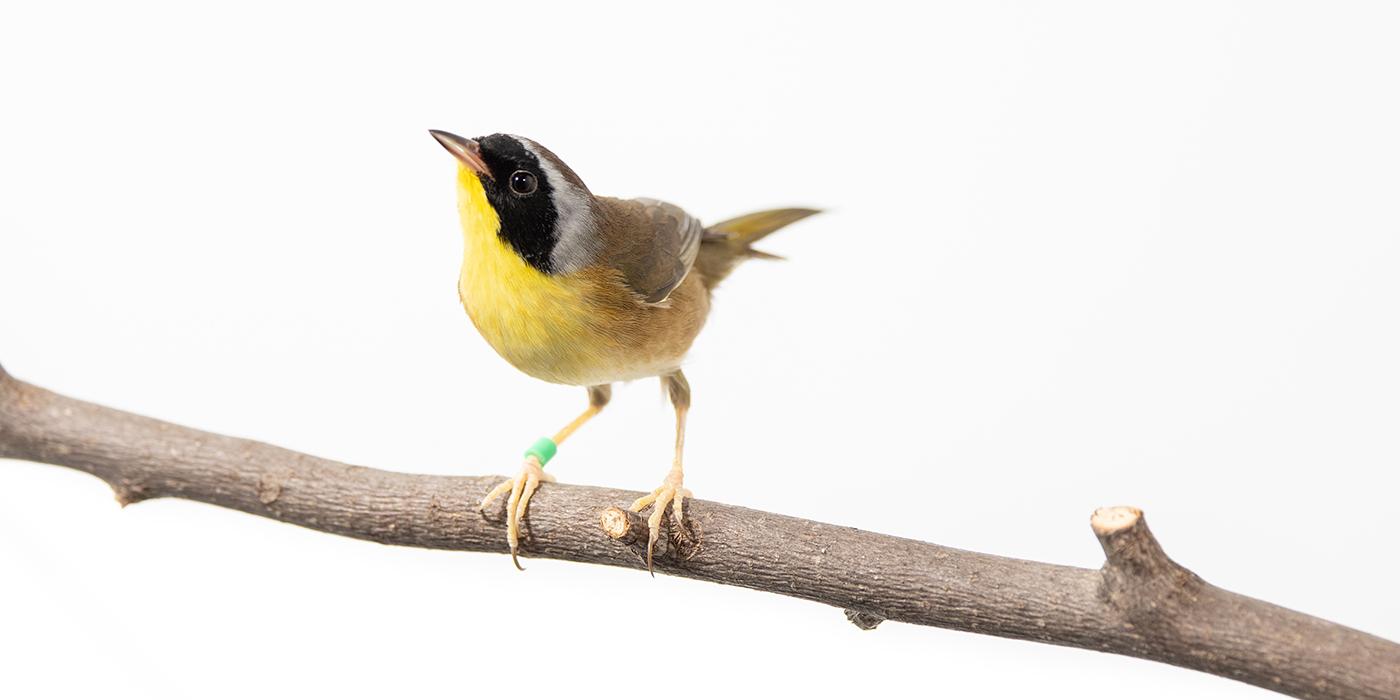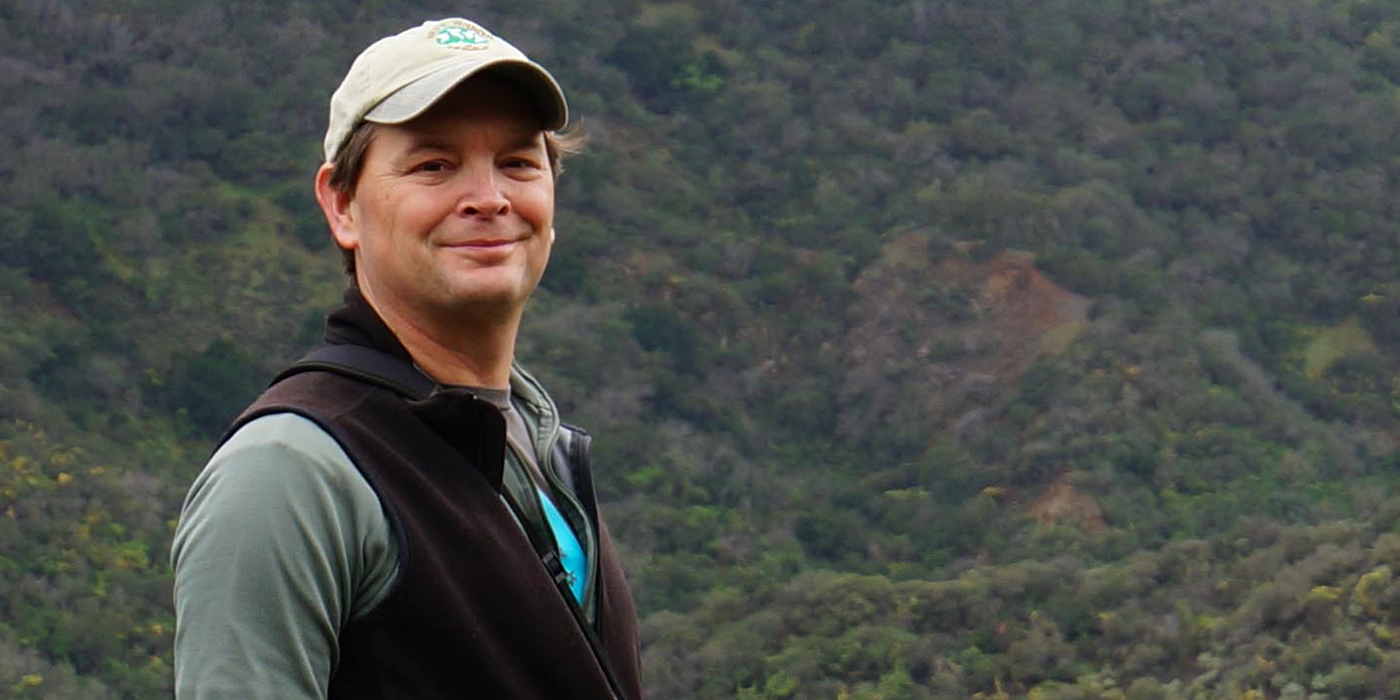Costa Rican Pollination Study Expedition Blog
Sustainable Coffee
We have returned unscathed from another successful field expedition! It was so great to be back on the farm, explore the beautiful landscape, and reconnect with friends. The last half of the sites were a bit treacherous…in some areas the vegetation around the coffee plants had grown waist high. We used walking sticks to push the vegetation down and create a pathway on our search for the marked coffee plants—saying loudly "Go away, snakes!" along the way : ) The snakes don't want to be bothered by you anymore than you want to be bothered by them—but I am not a fan of stepping anywhere where I cannot see my feet, especially in the tropics where there are an abundance of poisonous snakes.
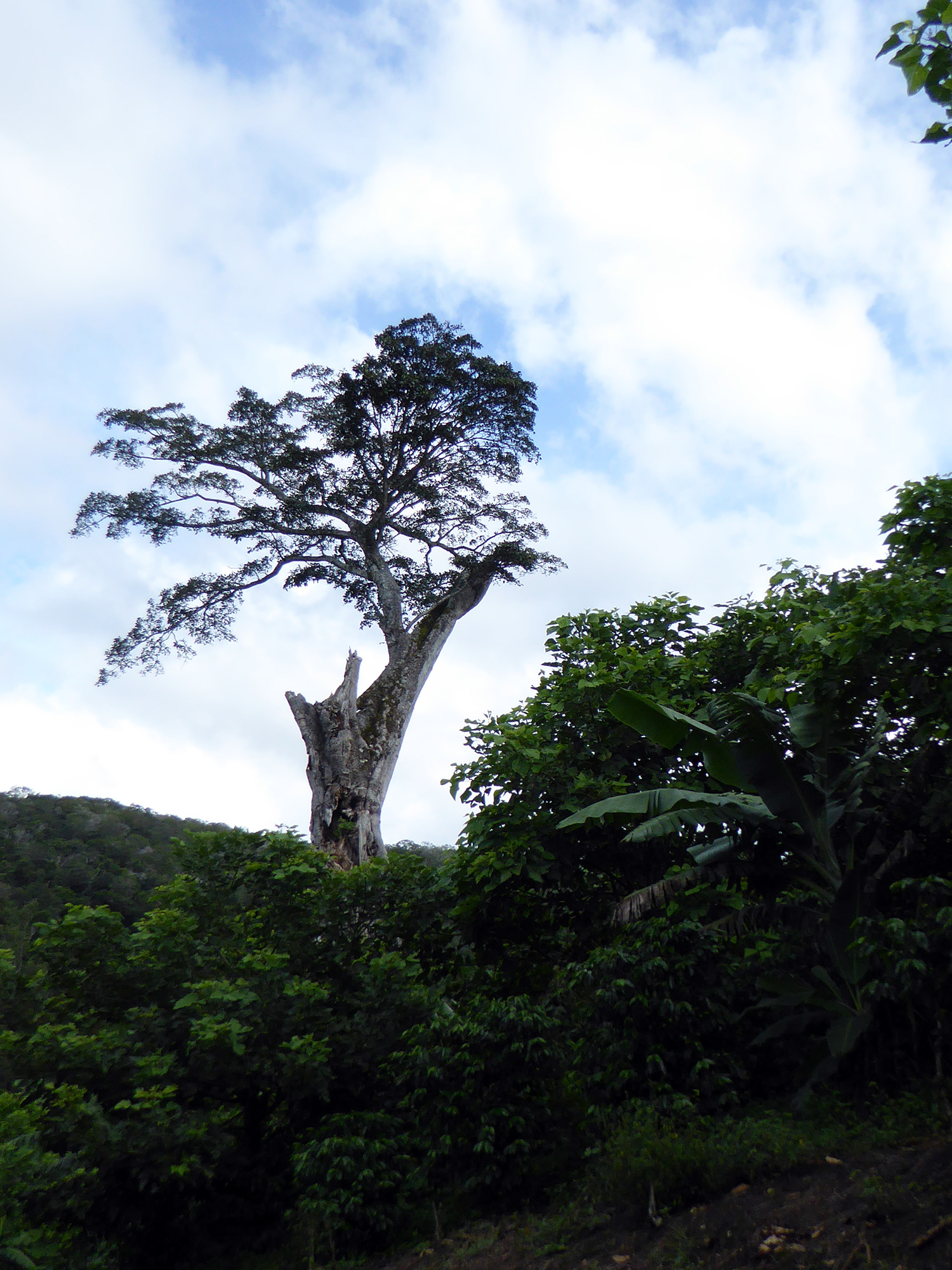
Miraculously, we found each and every one of our marked coffee plants. There were times when I thought we would have to give up on a couple, but we found them! So now we have collected all the data for this pollination project. I have to admit that it can be hard to stay seated in front of a computer after being out the field, but I am really looking forward to submerging myself into this data to see what it tells us about the factors that influence the pollinator community.
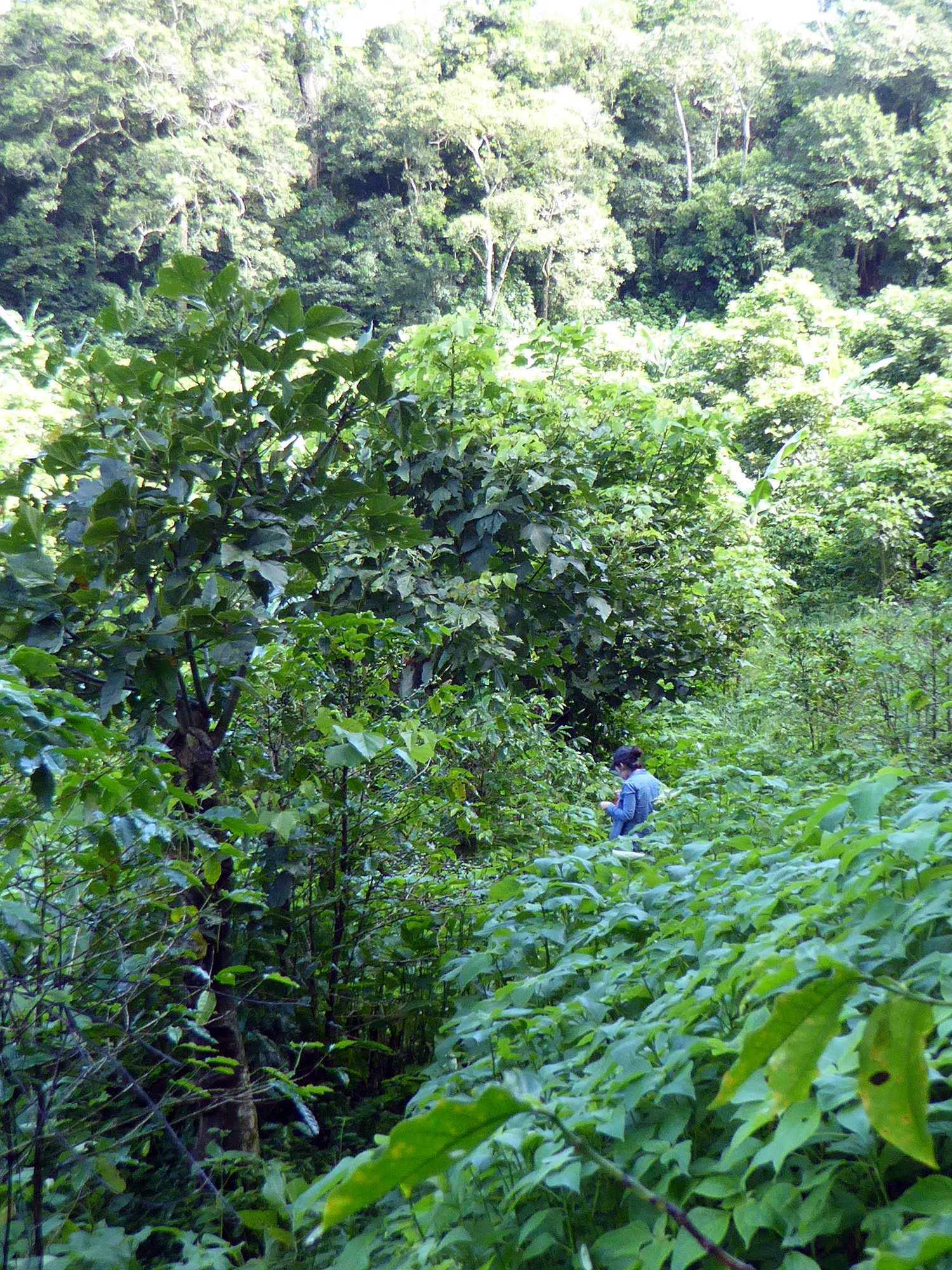
Oftentimes when I am on coffee farms and speaking to farm owners, my thoughts and conversations turn to the concept of sustainability. How do we categorize sustainability in coffee agriculture? What does it look like on the ground? Sustainable is a word that we often hear, but rarely have a clear understanding of what it means. It seems that everyone wants to produce sustainable products and since there is no clear cut definition of what that means, everyone is touting that their product is sustainable. The coffee industry is no exception. One of the greatest challenges is that defining "sustainable" for coffee farming might not be a one-size fits all scenario. This is something that I have seen throughout my years of doing coffee research in various countries and on various types of coffee farms—and something that I come back to time and again. A few stories might illustrate this point more clearly.
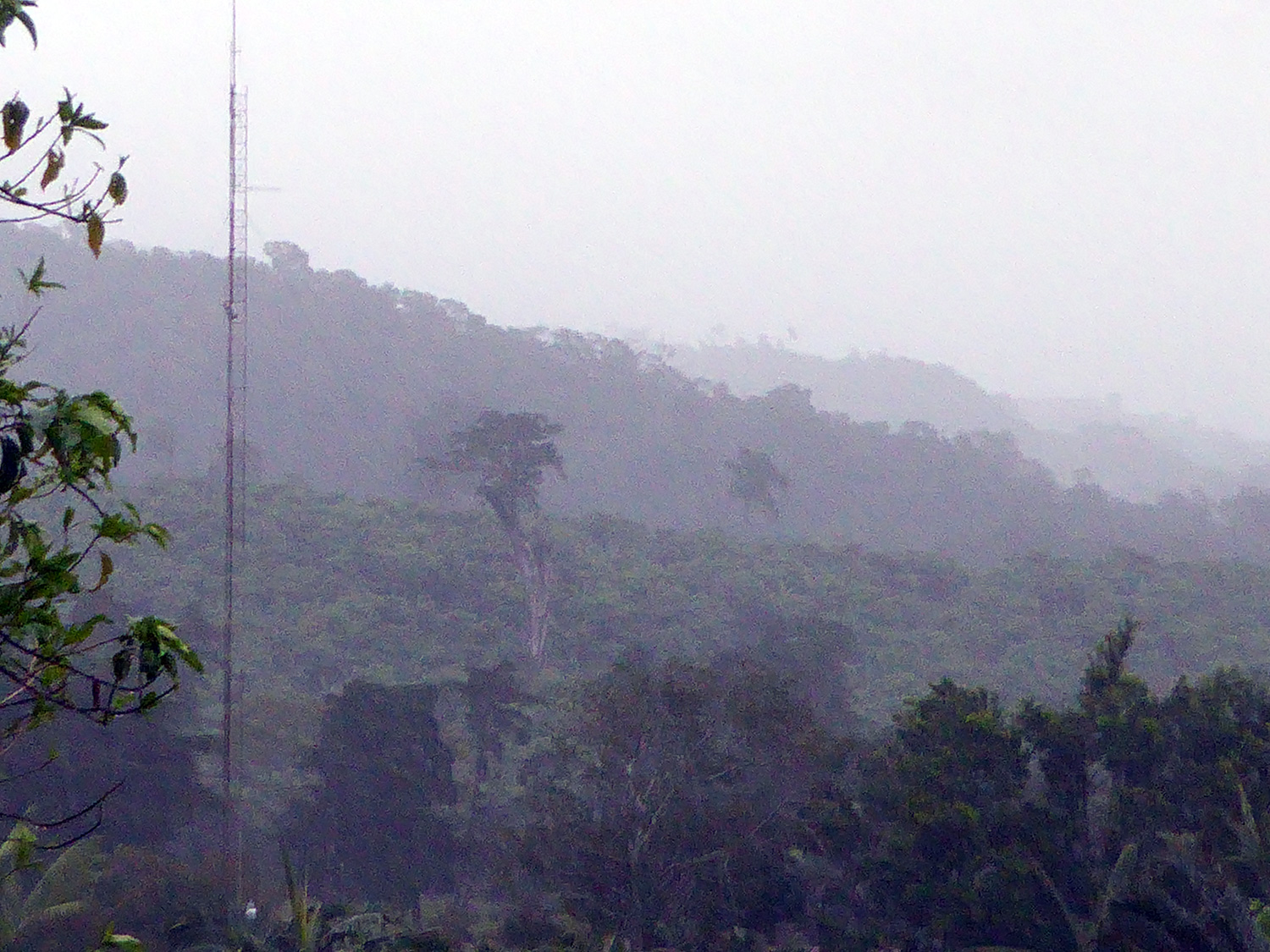
In India, I did research on a certified organic coffee farm. The farm owner abided by all of the standards and protocols within the certification. His coffee crop was healthy, his plants were not subjected to harsh chemicals, and the waterways within his farm were protected by a vegetation buffer. However, the people who worked on the farms lived in small structures that were nothing more than concrete boxes with a hole for a door and window—no running water, no electricity. A family with children lived in one right next to the oxen stables. There was no access to healthcare or education. When I asked the owner about this, he became irate—who are you to come here and ask about education and labor?! Not everyone should work in an office! If people are educated, who will pick the coffee?! — So was this farm sustainable—yes?…at least environmentally, but was it socially responsible? Definitely not.
One of our research sites in Mexico was previously considered shaded and certified organic, but the farm owner started using chemicals that are not approved by the organic label and removed many of the farm's shade trees. These were not easy decisions for the owner. His farm was devastated by a disease, coffee leaf rust, which has wiped out crops worldwide. To save his farm, he cut down the shade trees to sell as timber and he used agrochemicals to combat the leaf rust. He researched which chemicals to use, selecting the ones that were the most environmentally friendly but also effective against the disease. He feels fortunate that his farm was able to survive, knowing many coffee farmers that lost everything. He has set up a nursery and is breeding plants that are more resistant to coffee leaf rust. He will donate these coffee plants to those farmers who lost their crops so they can start over. —So is this coffee farm sustainable—yes?…although not to organic standards, but still environmentally friendly, and socially responsible, yes. Does a farm have to comply with organic standards to be environmentally friendly? What about farms that do not use chemicals at all, but just don't have the organic certification?
Then the coffee farm we just came from in southern Costa Rica could be seen as a model of sustainability…well maybe not by everyone. It is certified organic and although they have had a challenging time of coming up with an organic concoction to treat the leaf rust, it looks like it is finally working. There is a coffee processing plant on the farm that is almost a closed loop in terms of resource use—they recycle their water and use it through the different processing systems, they use wood from the farm to produce energy, the ashes which are then put back on the farm for fertilizer. The farm owner provides access to health care for the permanent workers and the migrant coffee pickers that come to the farm for a couple of months out of the year during the harvest. The owners provide backpacks and school supplies for the children of the farm workers each year. —So is this coffee farm sustainable—yes?, and socially responsible, yes. But not so fast…not everyone would consider it to be the highest tier of sustainability because of the shade tree management on the farm. Let me explain.
There has been a lot of research, including my own, that shows that coffee grown under a diverse shade canopy can provide valuable habitat for local wildlife—but what constitutes a "diverse shade canopy"? How many different tree species? Specific tree species? Native trees? This is where things get a little complicated (if they weren't already). In most parts of La Amistad farm, there are only two tree species, well, one actually because banana trees are not really trees, but plants. The other tree is called poró (Erythrina poeppigiana) and is typically used on Costa Rican coffee farms because it provides nitrogen to the soil. This tree is really fast growing and it is pruned drastically within the farm. Almost all the branches are cut off, so it is just the trunk of the tree left. There can be a canopy leaf cover of 60 to 80% one day, then 0 to 5% the next.
The poró trees at La Amistad are managed in this way. The cut branches are left to degrade and provide nutrients to the soil within the farm. So having just one tree species within the farm doesn't really constitute a "diverse shade canopy", however the farm is surrounded by native forest with many different tree species, huge amounts of canopy cover, and very mature, tall trees that provide great habitat for wildlife. The farmer owns this forest land and has set up a conservation easement to protect it. So does that count as providing a diverse shade canopy? Do the trees have to be right in the coffee farm? Or can they be around the farm? This is getting into an ecological debate that has resurfaced over the past couple of years known as land sparing/land sharing. For coffee farms, land sparing = separate areas for the coffee and then land "spared" for forest or habitat; land sharing = shaded coffee so that the land is "shared" for both agriculture and habitat. There are many nuances to this debate that need to be investigated further.
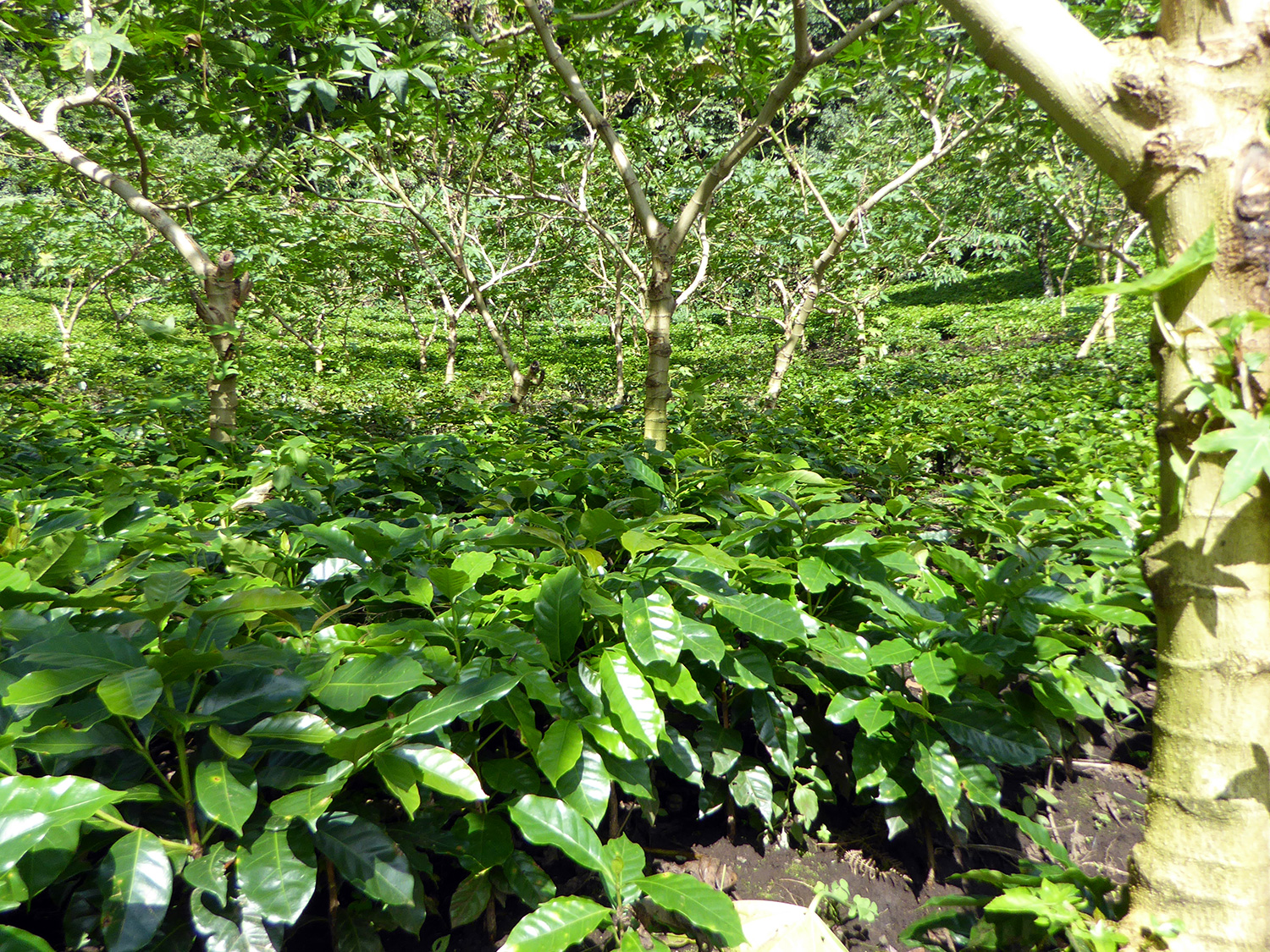
So from what I gather from being on the ground in these coffee farms is that the question of—what constitutes sustainable coffee—is one that needs further research. It is definitely not a simple yes or no answer. It does provide a lot of food for thought though—and more dimensions of coffee to research for me!
Return to Finca La Amistad for Coffee Berry Count
Six months have passed since we were last here at La Amistad farm in southern Costa Rica for our pollination study. In those six months, coffee berries have grown to replace the coffee flowers and the rains have transformed the vegetation on the farm. Everything is green and lush, flowers are everywhere, and the dusty dirt roads have been taken over by various grasses and weeds. We are in the midst of the rainy season, also aptly referred to as the green season. Field work in the tropics during the rainy season can be tough. The paths are slippery, your clothes and boots never really dry, it is easy for things to become mildewed and smelly. It can be beautiful in the mornings and then downpour all afternoon and evening—or it can rain and rain and rain for days on end.
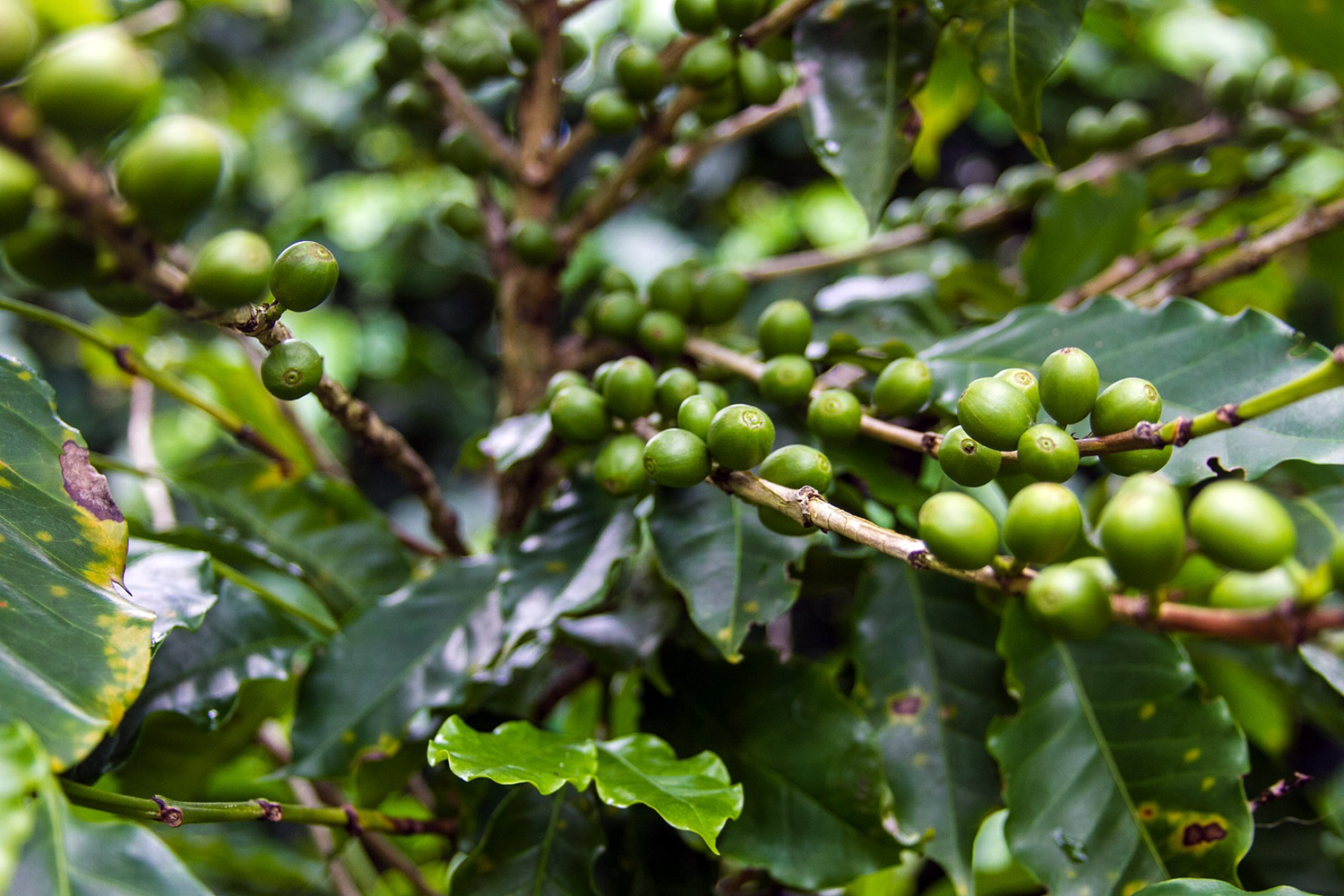
For this part of the field work, we are back on the farm for only a short stint to collect data on the fruit set of the coffee plants. This is representative of the coffee yield and we will see how that ties into the pollination data that we collected when we were here last. We selected two coffee plants in each of our 18 sites last time and counted each and every coffee flower on the plant. We are back now to count the coffee berries. Now if we can just find those exact coffee plants out of over a million on this farm. Even though we thought of this ahead of time, I have been concerned about how successful we will be in finding the plants.

- We marked each plant with orange and red biodegradable flagging—I have been concerned though if that flagging would still be around six months later, especially in the tropics where things degrade at an accelerated pace.
- We noted the coordinates of each plant with a GPS unit—the issue with that is the accuracy, between the satellite error when marking the point and then the error when relocating it can be about + 10 m which is a lot when you are looking for a single coffee plant in rows of many.
- We marked the plants with metal tags fashioned from cut up beer cans—but will we be able to see those once all the leaves are on the plants?
- We made flagging of white electrical tape and wrote "STUDY" in Spanish on them—so that hopefully the farm workers wouldn't prune our study plants—a real concern in an active working farm.
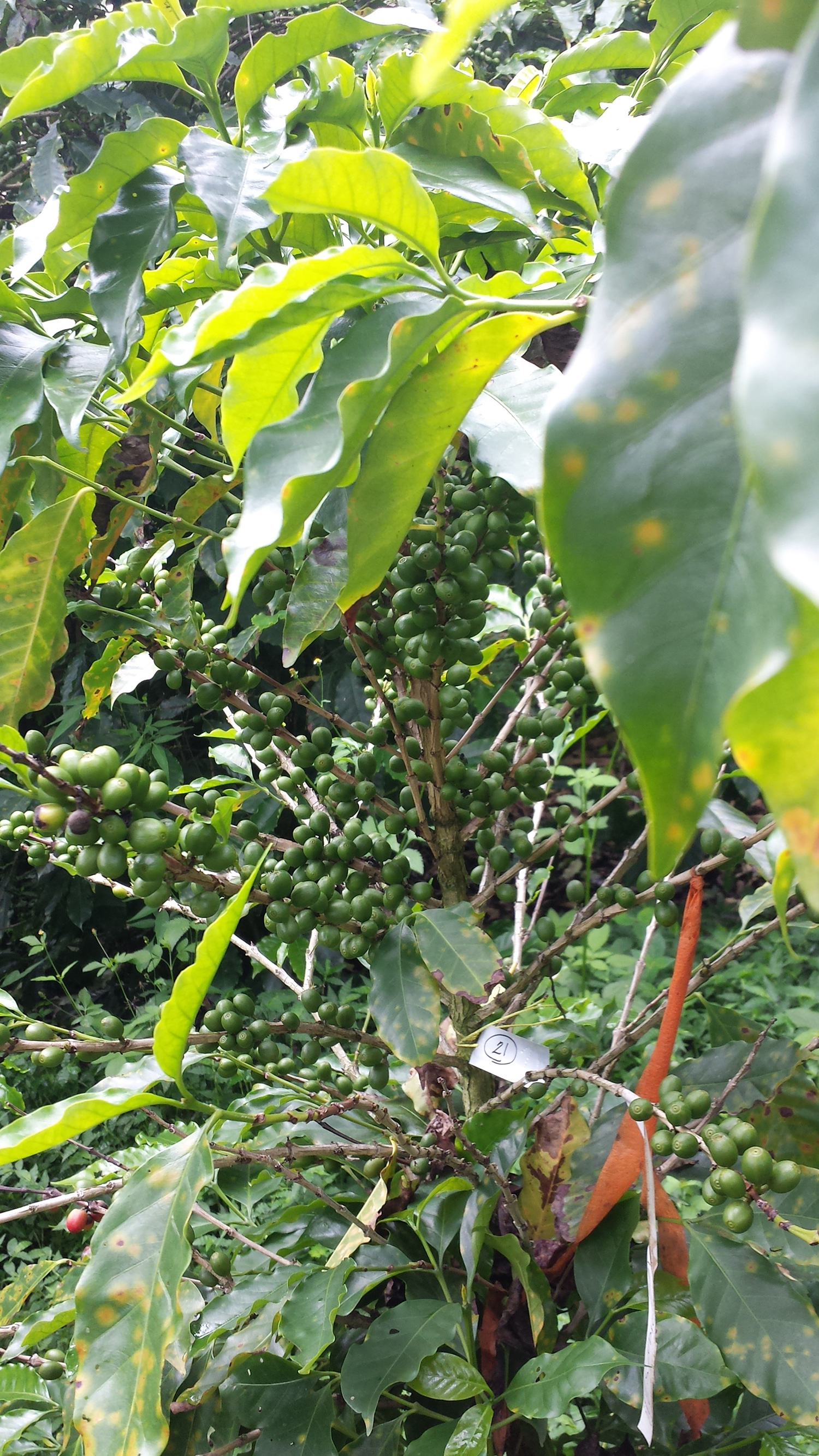
By the time we were done adorning the study plants last time—they looked like dressed up Christmas trees, but even so, I have worried about finding each specific plant in such a large landscape.
The weather has been beautiful since we got here. The mornings are glistening and bright and the rain gods permit us to complete a couple of hours of field work before the skies open up and we run to take cover. Our first couple of days went surprising well! We remembered how to get to out sites in the more shaded coffee. The orange and yellow flagging was falling apart and faded, but still somewhat visible on the coffee plants. The sites had more ground vegetation than six months ago—so we had to poke around for snakes and holes in the ground and be careful to watch our step—but nothing too treacherous. On the way back from the shaded coffee area, we stopped by to check out the other portion of our site that were before in the sparsely shaded area…that is no longer the case. In six months, the shade trees that were pruned and cut back are now fully leafed, grasses, tall weeds, and shrubs are up to our thighs, and the coffee plants are barely visible through the vegetation. Finding coffee plants—much less any flagging or tape—within these sites might present a bit more of a challenge.
All About the Bees
The coffee has flowered!!! And just in time!! We went from having a lot of down time to working 12 hour days. There are no complaints here though—we have all been excited to finally start the pollination portion of the study!
There are thought to be thousands of different species of bees, so identifying which bees we are catching is no easy task. Pollen is nutrient-rich and full of protein, making it a great source of nourishment for young bees.
Female bees collect the pollen to bring back to the nest, while the males collect pollen to eat for themselves, but do not contribute to the hive. Some of the native female bees here have what's called a scopa on their legs that holds the pollen. It is basically a hairy patch on the outside of leg that the pollen sticks to so that it can then be carried back to the hive. You can see the bees pushing pollen from their bodies onto these scopa with their front legs. The collected pollen looks a little bit like knee pads, especially after the bees have gathered a lot and the scopa are bowing out.

Some of these bees really take their time gathering pollen, crawling into the flower and then going up and down every anther meticulously. Then other bees, like the honey bee which is native to Europe and Africa, buzz with lightning speed from flower to flower in search of nectar, but not at all concerned about the pollen. There are even some bees, like the bumblebee, that can use what's called buzz pollination or sonication to collect pollen due to their large size. They basically situate themselves in front of the flower and then vibrate their flight muscles to shake the pollen out of the flower and onto their body! Then there are other bees that cheat and partake in "pollen robbing," making a hole in the bottom of the flower and sucking out the nectar!
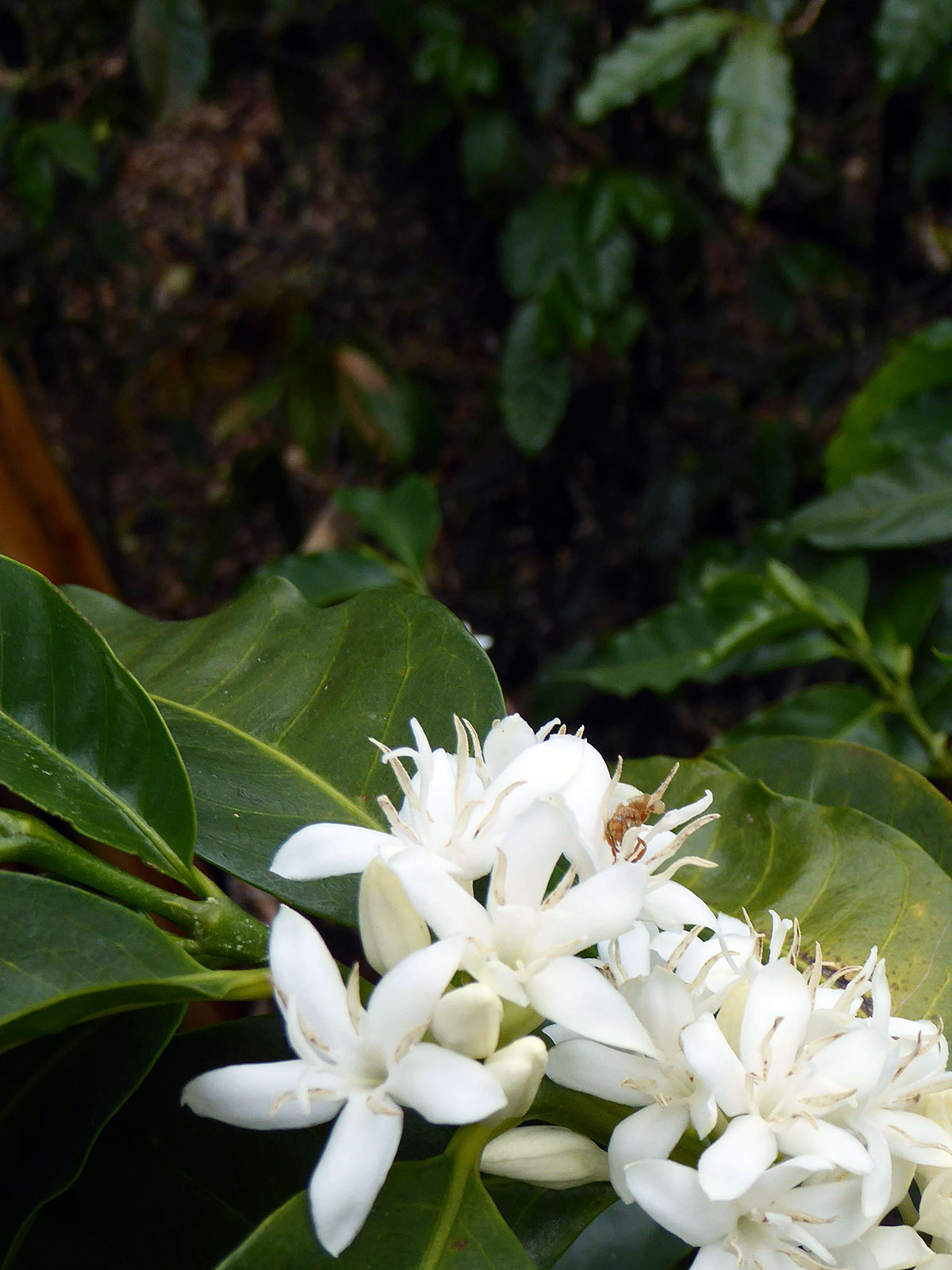
The coffee flowers are beautiful, dotting the sea of green plants with white blossoms. The flowers bloom in bunches and create a ring of flowers along each branch. They give off a jasmine scent that permeates the air when the farm is in flower. I have heard rumors of perfume made from coffee flowers. We are hoping that once the farm is in full flower, the scent might even be strong enough to cover up the smell of the organic compost used as fertilizer (and maybe the scent of our field clothes at this point).
I like to reserve a little space in the final field blogs to divulge some details that we have kept under wraps so as not to worry our mothers. This field season has been pretty uneventful in that regard, honestly. There have been no scorpions in people's shoes or clothes, no machete accidents, nor snake sightings as in my past research trips.
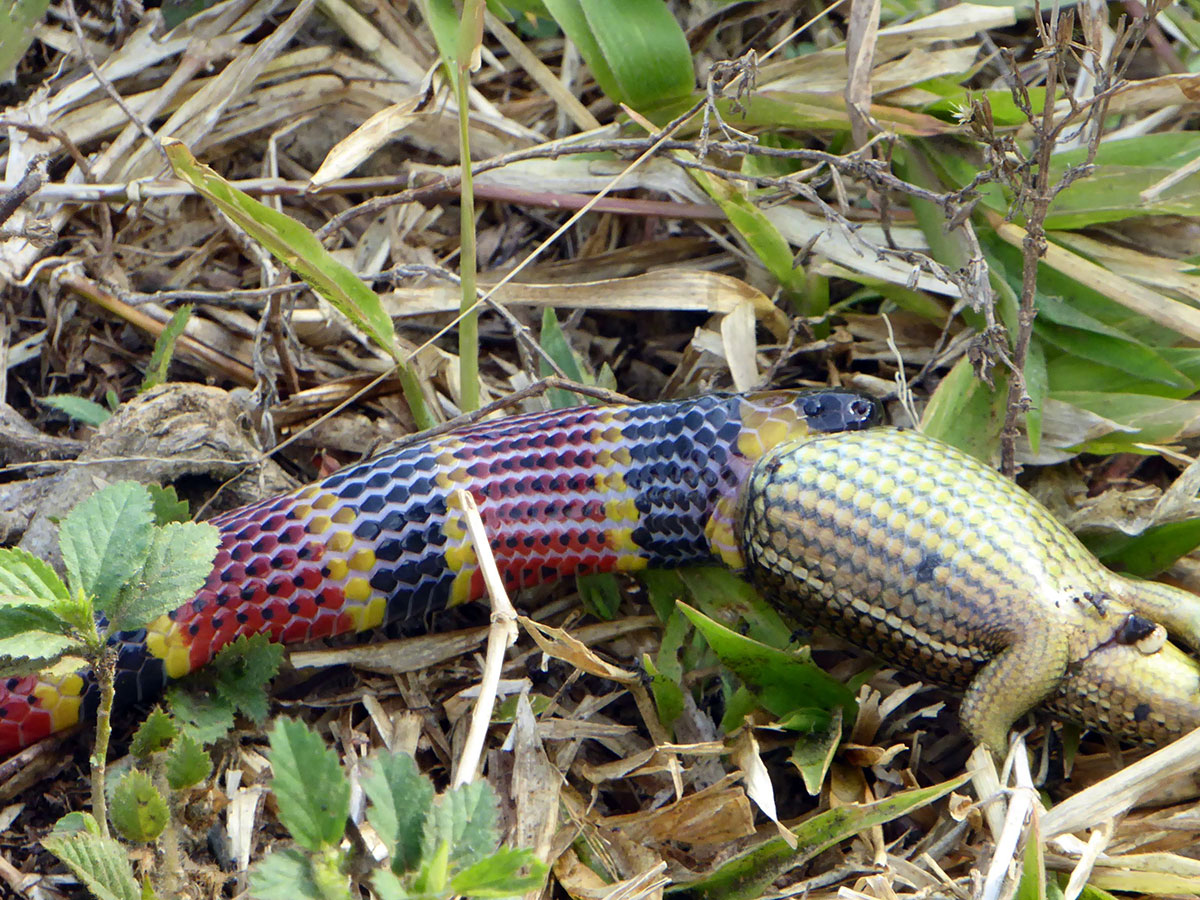
However, Julia and I came across a highly venomous coral snake the other day, luckily when its mouth was already full! We watched it eat for a little while, amazed at how it could fit such large prey into its mouth. The order of stripes on a snake can determine the species and tell you whether it is poisonous or not. On this trip I also learned a new acronym for the color order in Spanish for poisonous snakes—RANA (which means frog in Spanish): rojo, amarilla, negro, amarilla (red, yellow, black, yellow). That makes a lot more sense to me than the one that I learned and can never remember correctly—something like red and yellow, kill a fellow; black and red, friend of Fred or you're dead…I'm not sure how it goes.
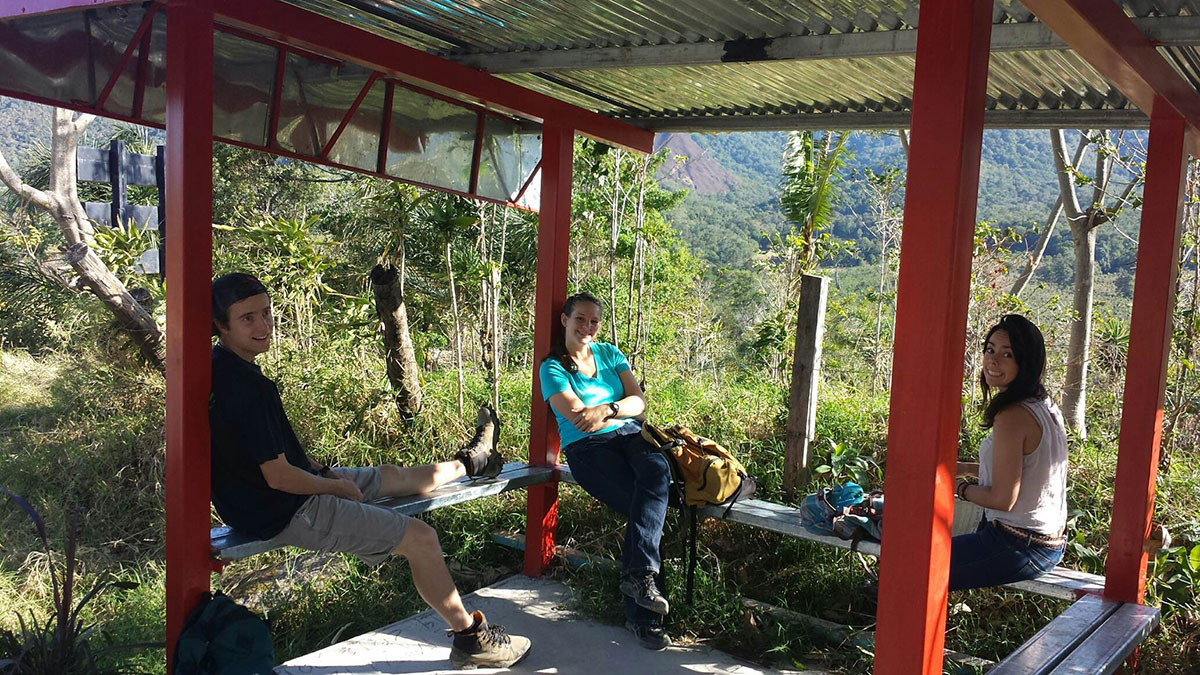
This has been a fun research project and we have been fortunate to live on such a beautiful coffee farm and get to know so many great people that live and work here. I would like to take a moment to thank my field team, Julia, Dejeanne, and Kristian, for all of their hard work, patience, and positive attitudes throughout this project. This research would not have been possible without them. Hopefully all of our efforts will pay off and we will be able to see what impact shade trees and forested areas have on coffee pollination.
Also—thanks to my sister, Ashley, for proofing and editing the blogs. Lastly, I want to thank all of you for reading these entries and following along with our adventures in the field.
Camera Traps

The rains have finally come! They are a month late…but I'll take it. There has not yet been enough precipitation for the coffee to flower, but we are hopeful that the farm will be in bloom sometime this week! In the meantime, we have been staying busy—surveying our sites, practicing our Spanish, trying out Costa Rican recipes, doing some yoga, taking hikes through the forest, and watching the sunset.
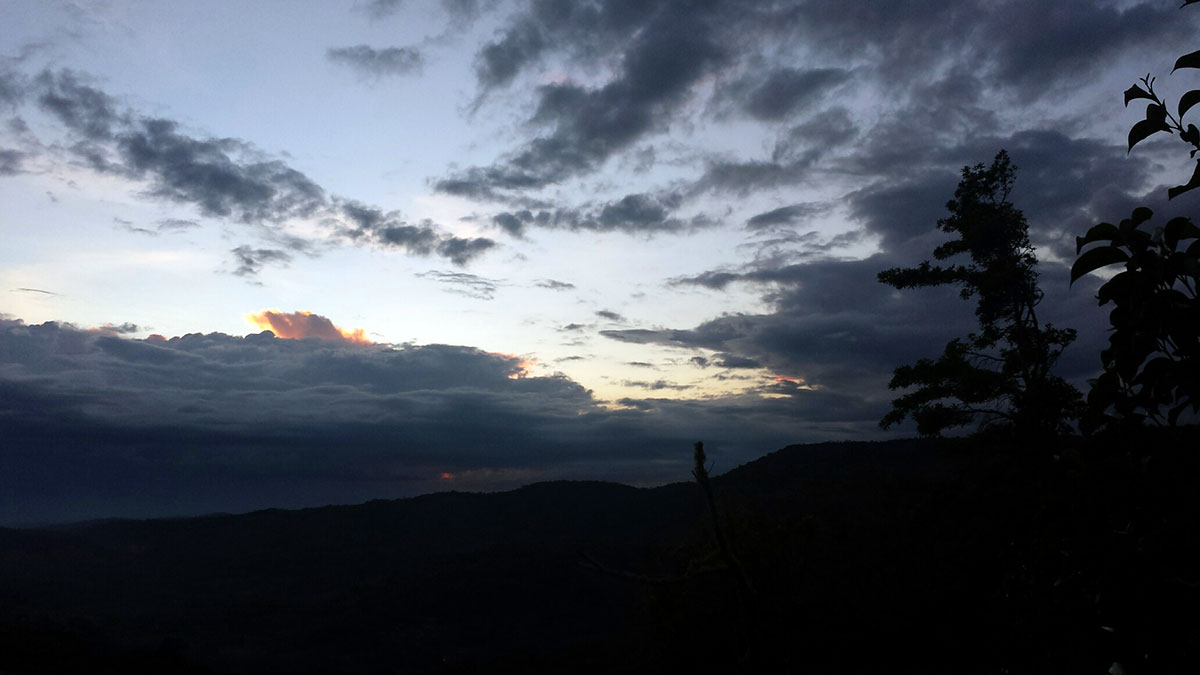
As a side project, we have set camera traps in the forest adjacent to the coffee farms. The camera traps are infrared so they can take black and white pictures at night. There is no incandescent flash that might deter animals. The cameras are triggered by motion, so if something crosses the line of sight, the camera will snap a picture. We have had a lot of success with the camera traps here! One of the first weeks that we set the camera up, we got this photo of the hind quarters of, most likely, a jaguarundi (Puma yagouroundi)!
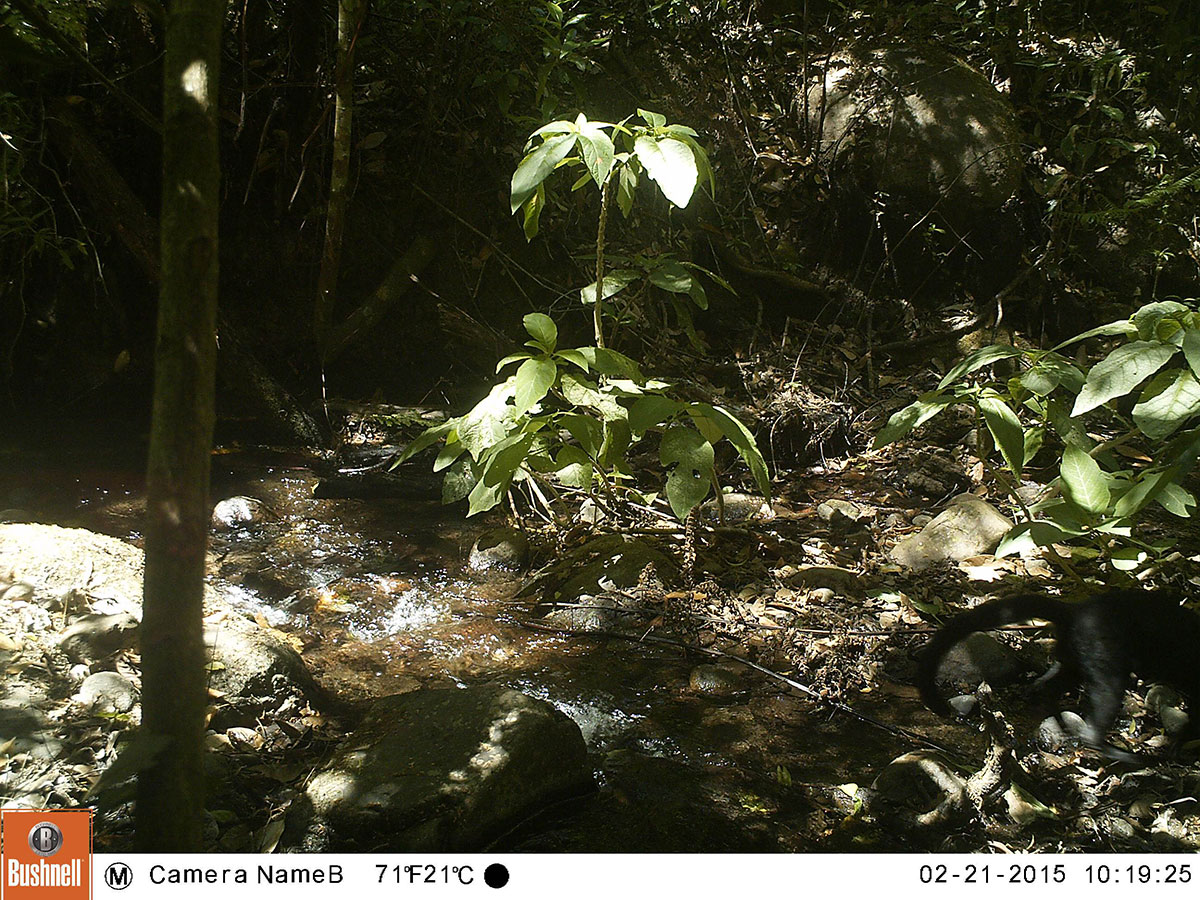
Although we can't say for sure, obviously, but there are no other all black animals that size with that tail in these parts. Jaguarundis are slender cats with small heads and long, narrow tails that can be about four feet long from nose to tail. They are not very common, although the farm owner has seen them around here. These animals are diurnal, meaning they are active during the day. This photo was taken at 10:19 a.m. and we came to check the trap at 10:40 a.m. that same day! We are still hoping to get a good photo of the full cat.
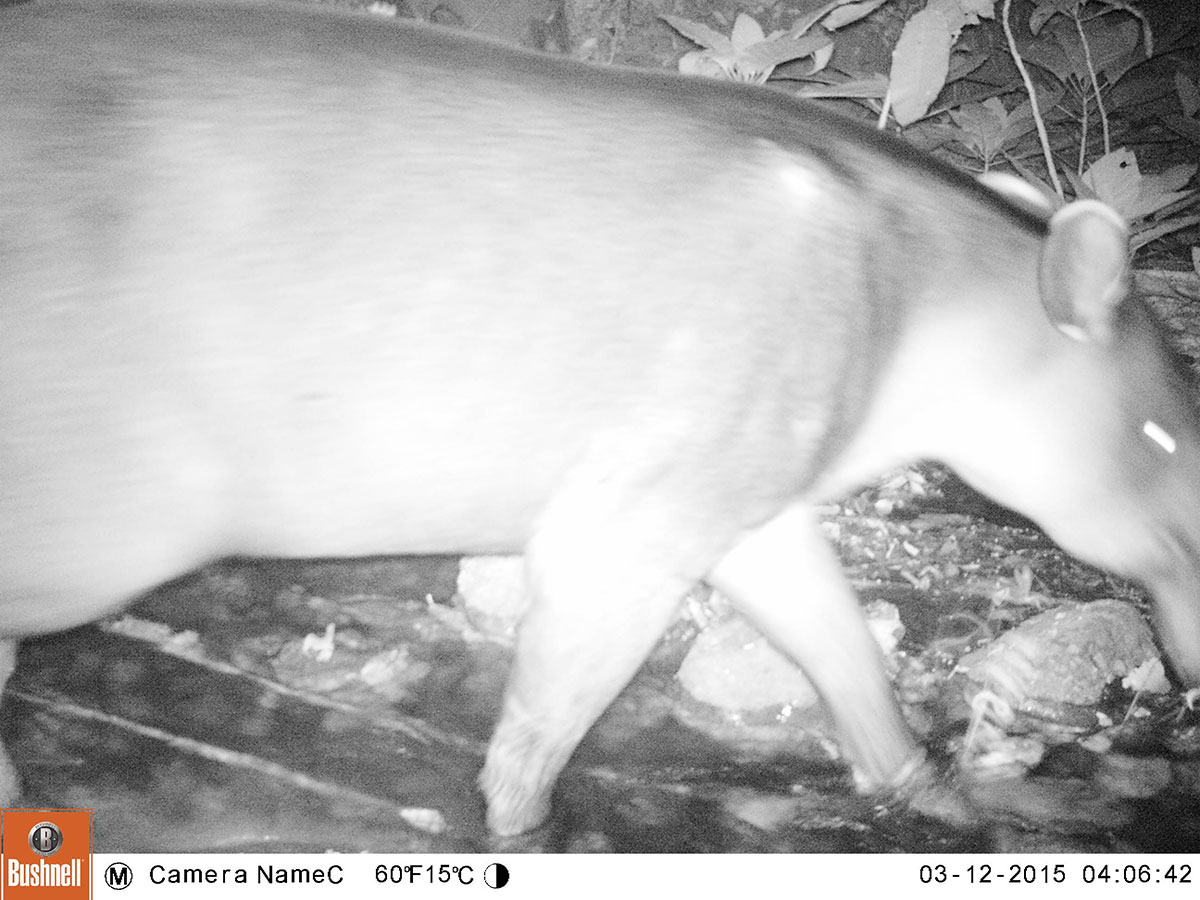
We also got this amazing photo of a Baird's tapir (Tapirus bairdii)! We had been getting photos of a small opossum at this site almost every time we checked the camera, so imagine our surprise when this huge animal appeared in the shot taking up the whole frame! They are enormous—measuring 2.5 to four feet high at the shoulder and weighing up to 550 pounds!
In fact, it is the largest land animal in Costa Rica. Their populations have dwindled due to habitat loss and hunting pressures. Baird's tapirs are now listed as endangered and very rare. It is thought that there are less than 5,000 adults left in the wild according to the IUCN Redlist. So we were very lucky to capture an image of this one walking along the banks of the stream.
This week, we put out a camera in a new location. A little deeper in the forest, but along a dirt roadway where Roberto, the owner, and Walter, the naturalist, had seen a puma before. Pumas are large cats—with a length from head to tail varying between five and eight feet and males can weigh about 150 pounds. They go by many different names—including mountain lions, cougars, and, according to Kristian, in Vermont they are called catamounts.
We set the camera out on Wednesday afternoon. Thursday morning Roberto and Walter start asking me if we got a picture of the puma yet. I have been using camera traps for the past five years with my mammal studies—I know how unlikely it is to get a picture of your study species in one night. But lo and behold, five hours after we set up the camera, the puma (Puma concolor) comes strolling up the roadway! Amazing.

Hopefully in next week's blog, I can share some photos of coffee flowers and bees! We will see…
Holding Out for Coffee Flowers
It is a sunny day here, not a cloud in the bright blue sky—beautiful weather same as always—which normally would not bother me in the slightest! However, it still hasn't rained, which means the coffee flowers haven't bloomed and we have not been able to start collecting the pollination data yet. There are still two more weeks before my field assistants disperse to resume their lives back in the United States.
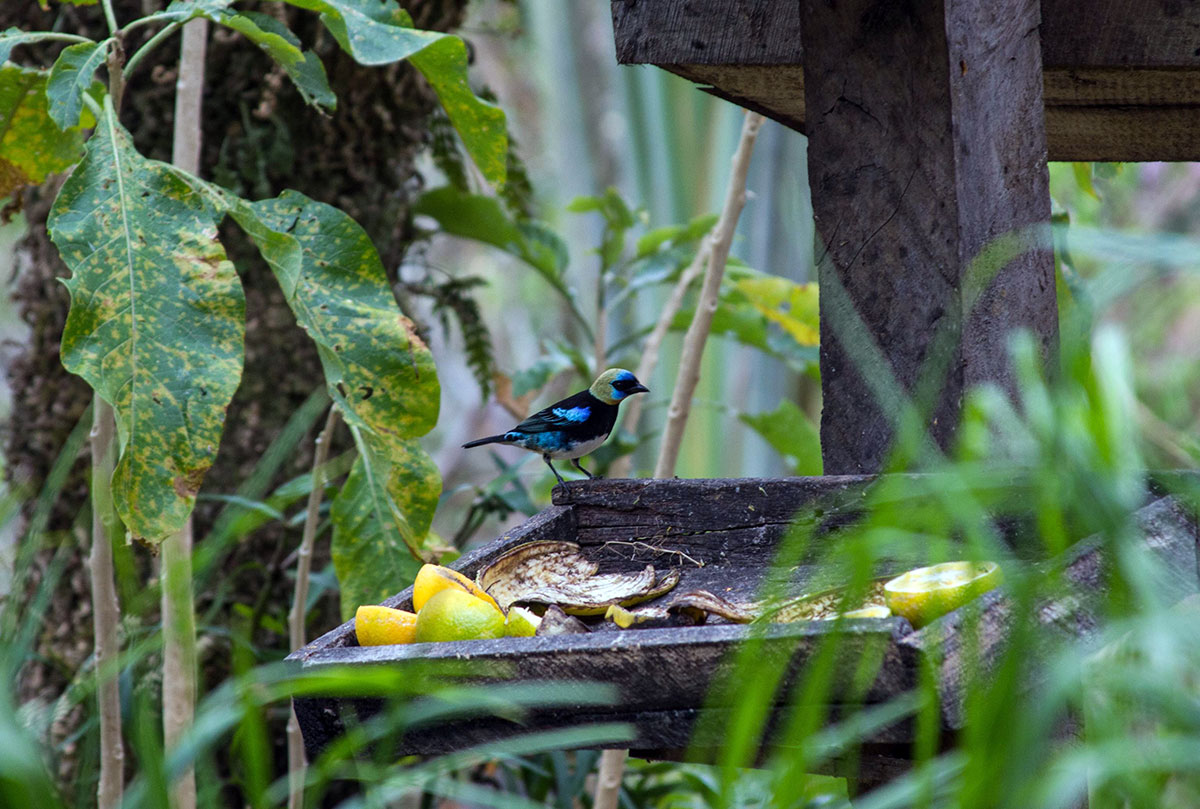
That is still plenty of time to collect the pollination data, but we are cutting it close. I am trying to be optimistic, so if anyone knows a rain dance, now would be the time to do it. It is just a weird year at La Amistad—there has been less rain than normal and many of the plants are recovering from coffee leaf rust. A guest at the Lodge inquired about our research, "If the coffee doesn't flower, will you go somewhere else?" Don Roberto, the owner of La Amistad coffee farm, interjected, "I will have to go somewhere else!"
The plants seem to be in a holding pattern, waiting for the rain, and once it comes, the farm will be in full bloom. The coffee flowers only stay on the plant for three days before they wither and fall off—so one good rain and three days of flowers are all we need to collect data. We will be really busy for those three days visiting each of our 18 sites between 8 a.m., after the bees wake up and get moving, and 2 p.m., after which the bee activity dies down. At each site, we will use two methods for collecting bees.
One is by setting up a bee bowl, which is nothing more than a small white bowl filled with soapy water. The second is by sweep netting—basically using a net to sweep along the coffee plants and catch any bees or other insects that are in the area. We will also conduct visitation observations. This involves finding some branches with lots of coffee flowers and then keeping a tally of how many bees come to pollinate those flowers within 15 minutes.
I loved my mom's comment a couple of months ago when I was describing how we were going to do this pollination research. She said, "So you are going to sit in a coffee farm full of flowers and watch bees…and are you going to be smoking something?" I mean, I completely understand where she is coming from—it does sound a little funny when you describe it, like a flower child's dream. But yes, I promise it is a true scientific study and no, we will not be smoking anything.

In the meantime—we have been walking through our sites every day and checking on the progress of the coffee buds when the cows will let us through. It is pretty common for a couple to get out of their enclosure every now and then, but one day this week it looked like the whole herd escaped!
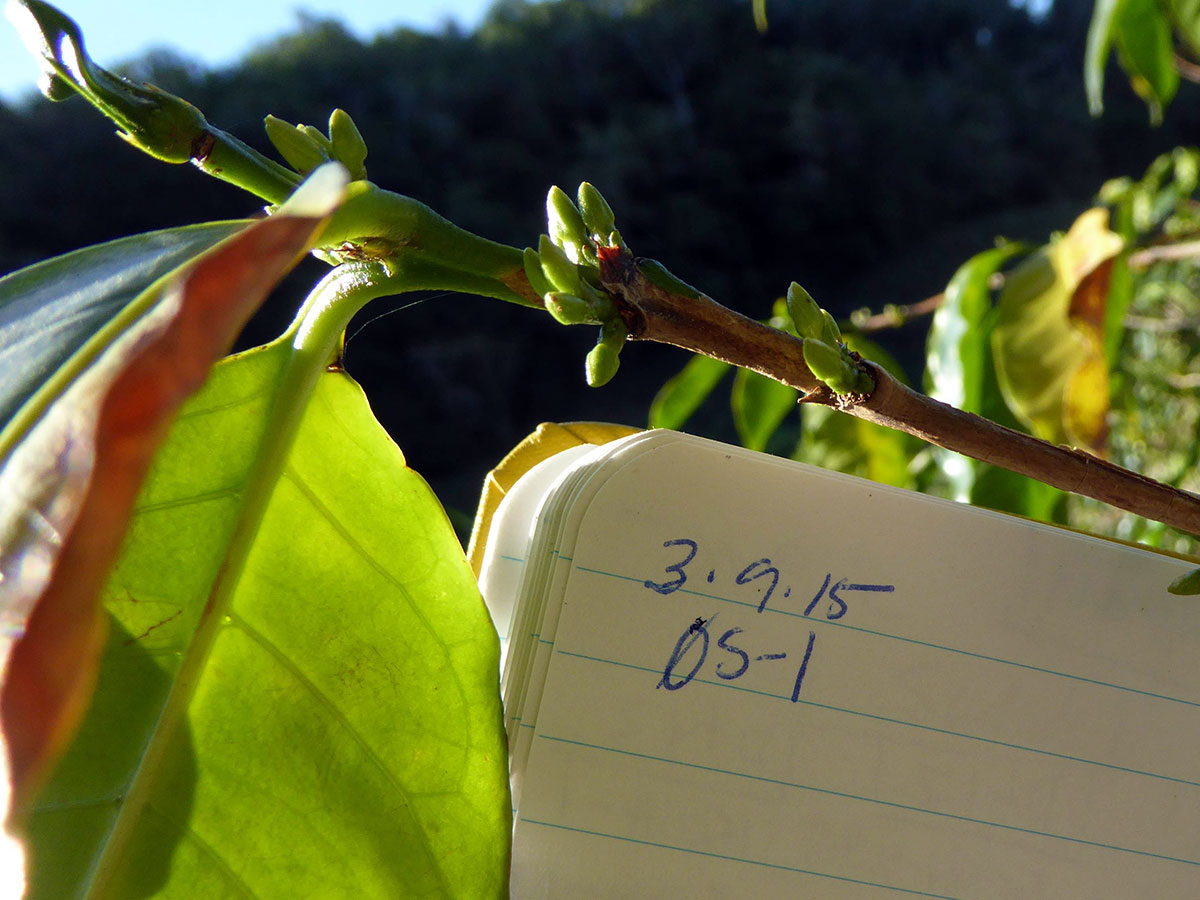
The coffee buds are still pretty small in most of our sites. Coffee farmers in Costa Rica usually plant Erythrina poeppigiana (poró in Spanish) on their farms because it is a nitrogen-fixer and enhances soil quality. The coffee plant has beautiful orange flowers that that you can see speckled across the landscape. I was able to study the details of the poró flowers on a branch that had been broken by the wind.
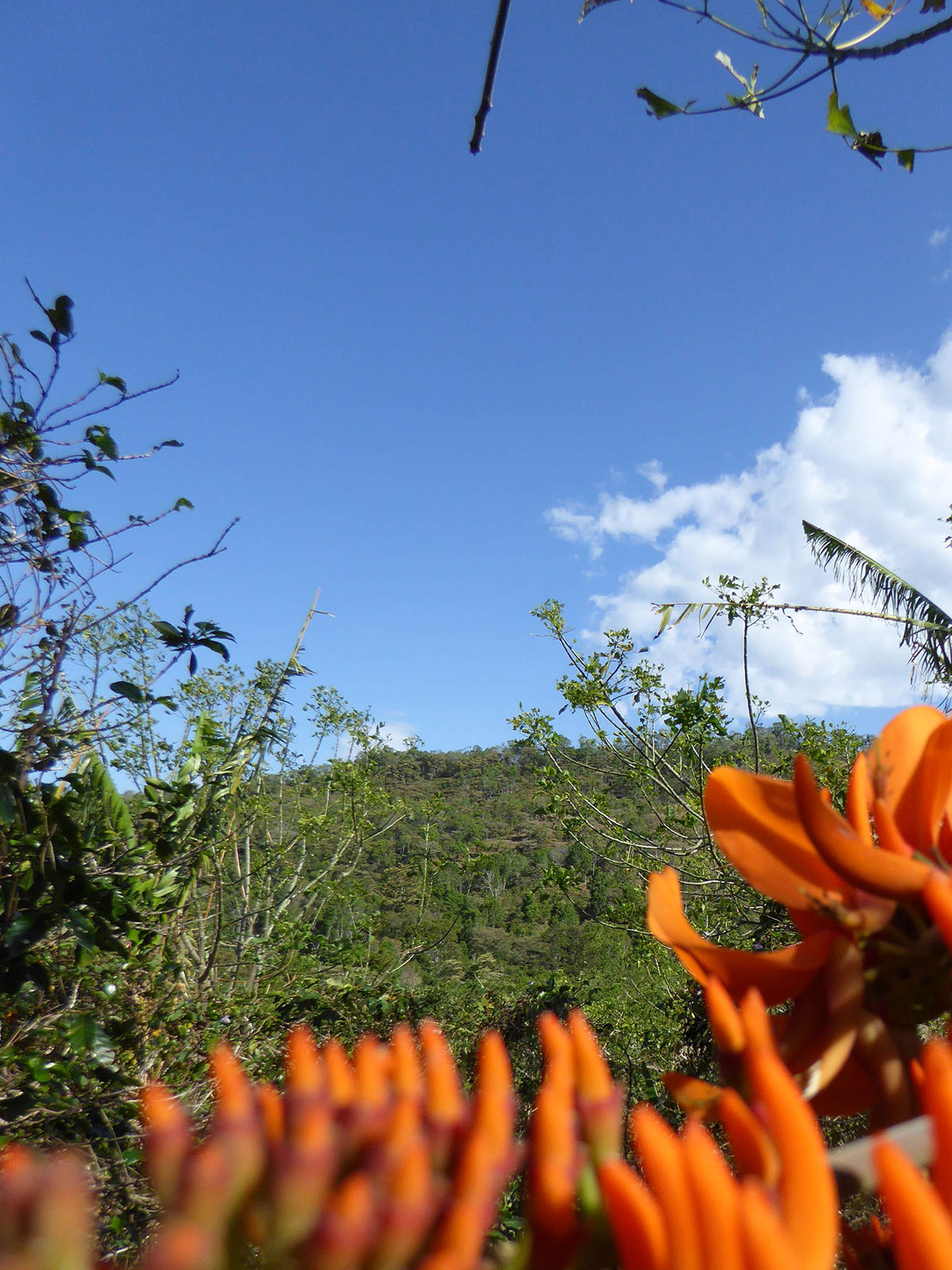
There is a small lagoon in one part of the coffee farm—where luckily, we don't have any study sites. Reto, a birder from Canada, went down to the lagoon the other morning looking for birds but found this speckled caiman instead! He said it was almost 2 meters long!
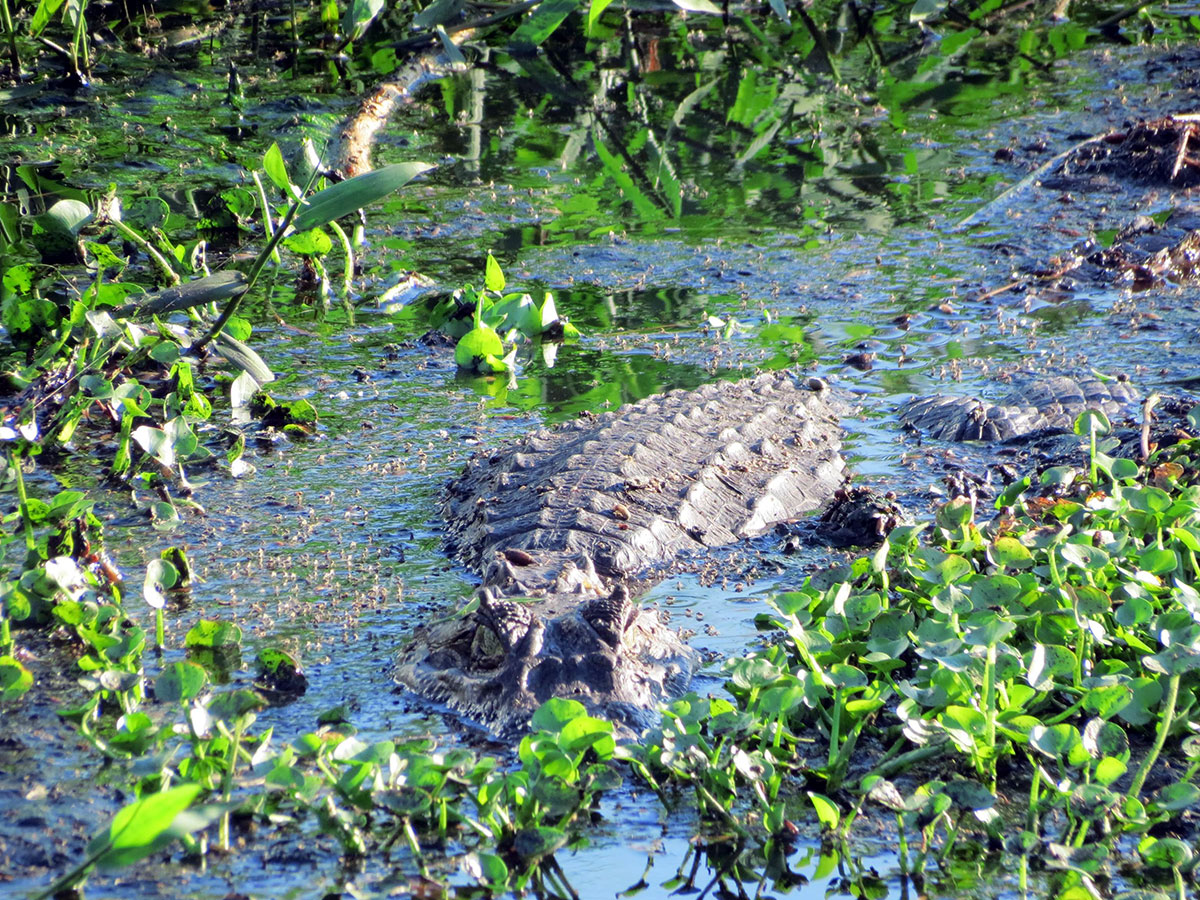
Our last field team member to introduce is Kristian Moore. He grew up in Pawlet, Vermont and just graduated from the University of Vermont last May with a degree in Environmental Studies, with a concentration in Ecology and Conservation. Kristian worked with Dr. Taylor Ricketts at UVM on pollination studies in blueberry fields.
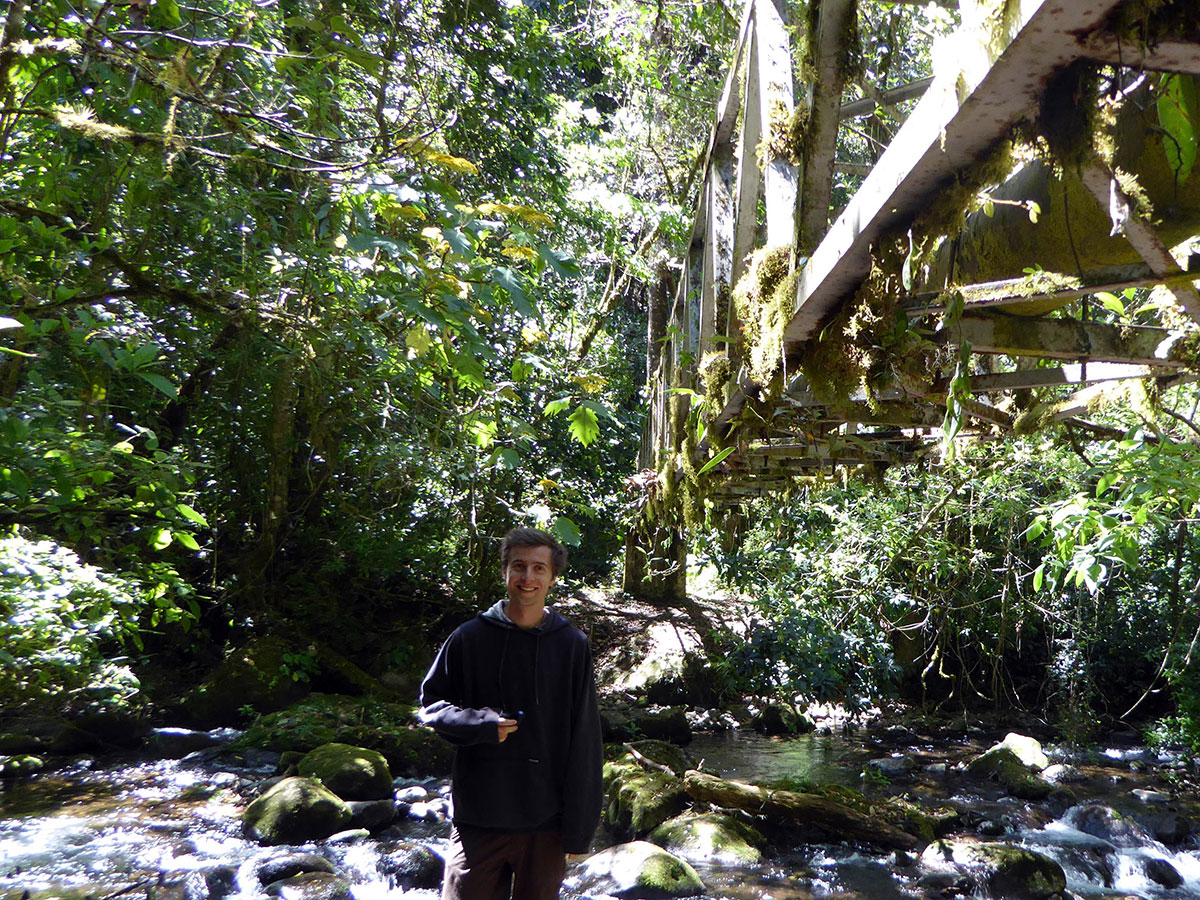
- What were your reasons for wanting to work on this project?
- "Throughout my undergraduate years I focused my studies on the ecology of temperate ecosystems, Spanish, and most recently the role of pollinators in agricultural landscapes. This research project was the perfect opportunity to combine all of these interests into one incredible learning experience. It was also a chance to get to know an unfamiliar tropical environment by studying something both landscapes have in common, bees. As I have come to realize through my stay here, I am not only more acquainted with the ecosystem but also a new country, culture, and agricultural crop that makes an appearance in the lives of most people every day."
- What are your favorite parts of the research project so far?
- "This research opportunity is especially interesting to me because we are not just conducting our experiments and driving home each day. Instead we are on the farm 24/7, talking with farm workers about bees and the state of the coffee, we share meals with the owner and discuss the history and inner workings of the farm and all the changes it has undergone over the last 40 years, and we get to witness how exactly coffee ends up in our mug every morning. I have seen coffee seedlings be planted, watched bees pollinate the flowers of mature plants, and ripe berries fill baskets by the hands of friendly faces, I have heard the processing plant run late into the night, watched green coffee dry in the sun, smelled the freshly roasted coffee, and tasted the freshest coffee of my life. All in a day's work."
- And lastly, what is your favorite local food?
- "My favorite foods without question are gallo pinto and banana. Gallo pinto is a mixture of rice and beans, it is incredibly nutritious, simple, delicious, and can be eaten with every meal, what's not to love. Bananas and plantain, as it turns out can be eaten in many different fashions, including but not limited to; raw, fried, grilled with a little butter, cooked in sugar, squished and fried when green, baked with, dehydrated, and prepared in almost any other fashion."
For the Bird(er)s
We are still waiting for the rain. The locals say that when it is really windy—the rains will not fall. And it has been really windy. I have never experienced wind like this before. It can sound like a calm ocean as it rolls gently through the trees or like rough waves crashing over you when the winds are blustering and swirling around. The wind is so strong that a gust blew a contact right off my finger before I could get it in my eye. It is so strong that it toppled a tree causing the roots to come up through the floor of one of the cabinas. The wind is so strong that my field team and I have to daisy chain ourselves together and use our arms to pull ourselves along the fence to check our sites…ok, that last one isn't true. Luckily, the winds usually die down around 6:30 or 7 a.m. when we are heading out to the field in the mornings and don't start back up until the late afternoon.
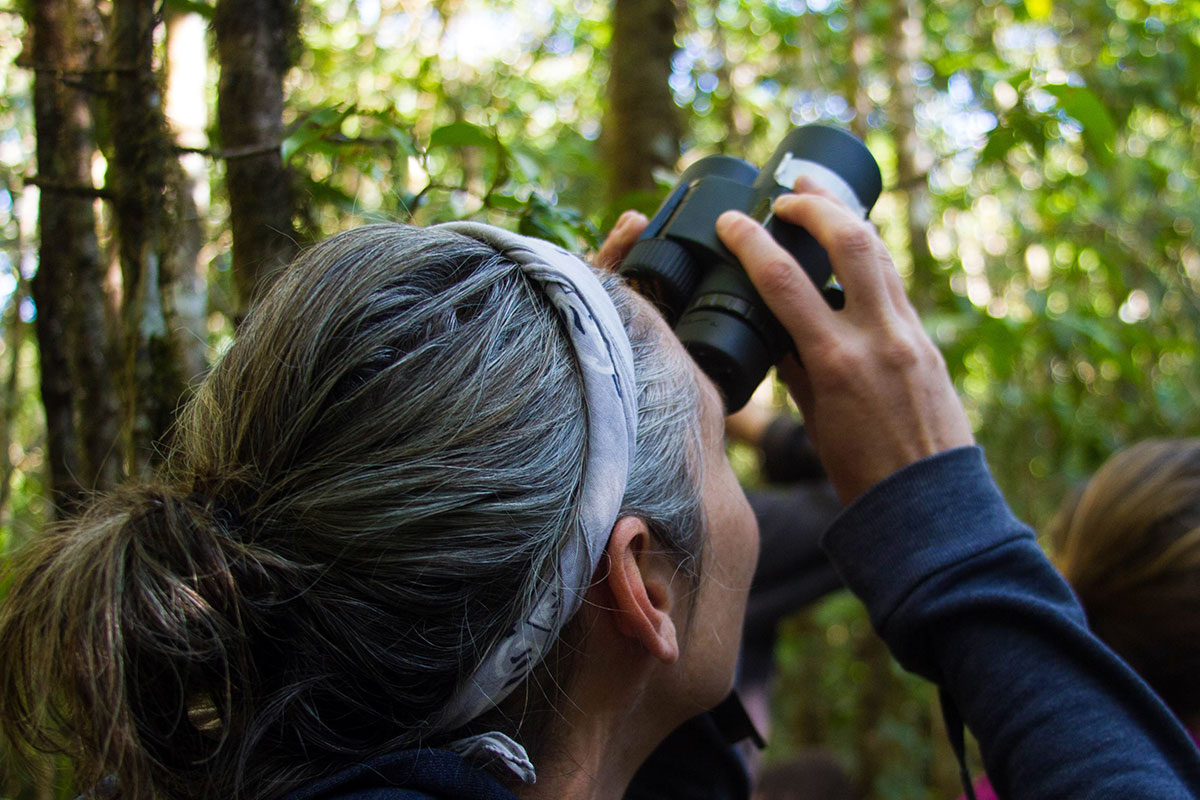
This week we have been on a couple of early morning birding expeditions with the naturalist on the farm, Walter. We explored a couple of trails right around the farm and saw a collared trogon (Trogon collaris) near a stream.
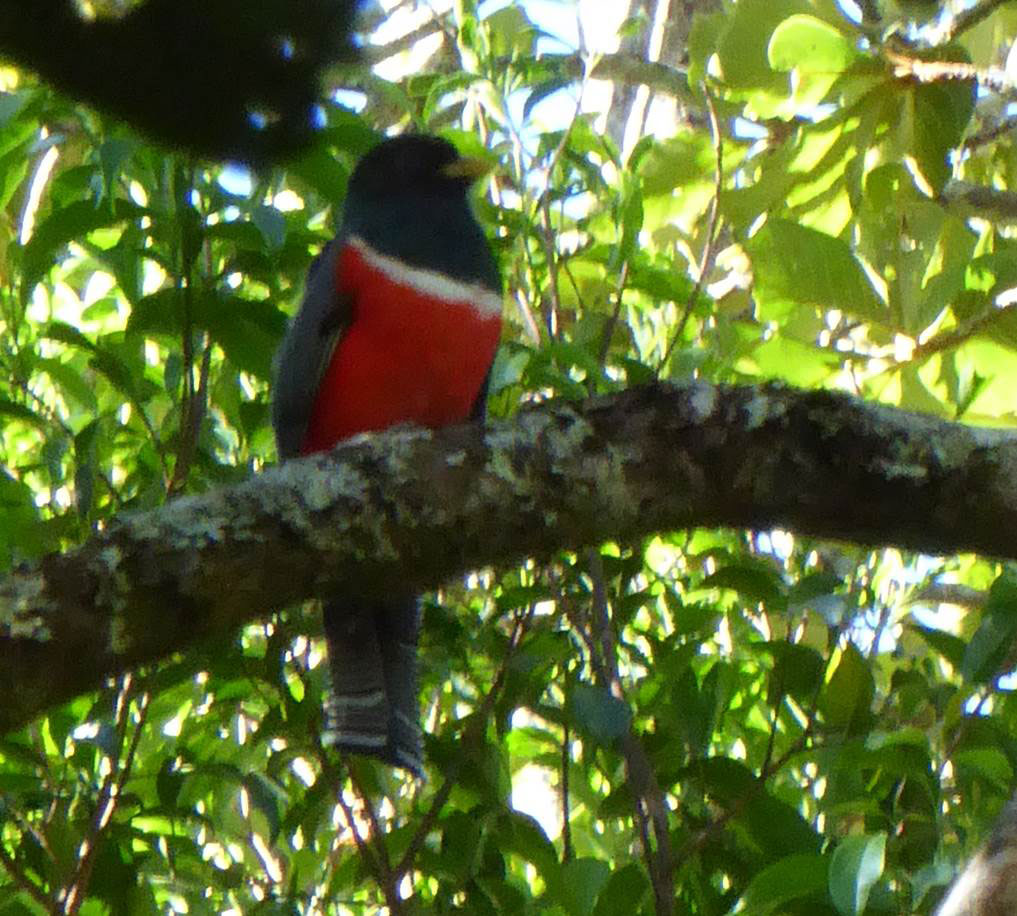
We also tagged along to a forest site a little further away, Las Tablas, with a couple of birders. The forest here is amazing!
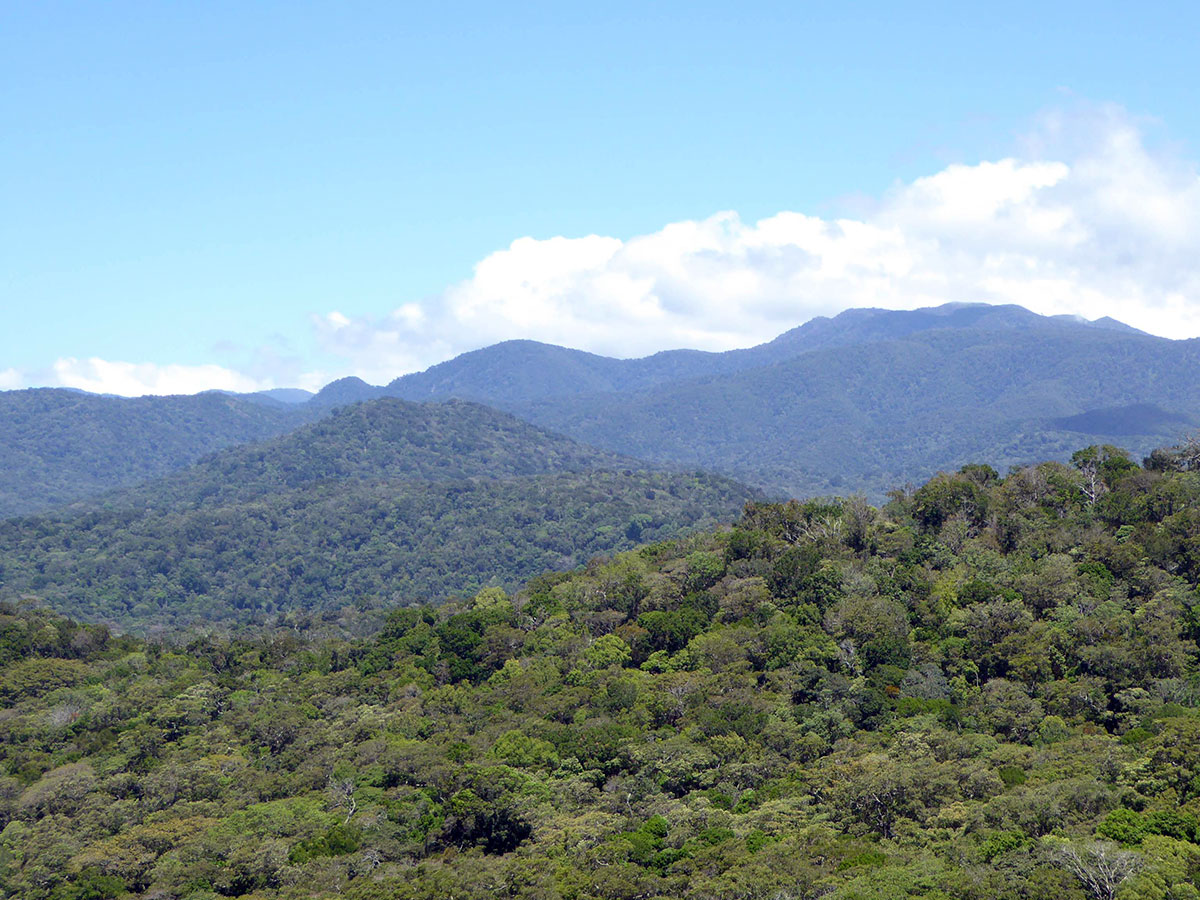
According to Walter, this forest is home to a ton of animals—all four species of monkeys found in Costa Rica (howlers, capuchins, spider monkeys, and squirrel monkeys), along with jaguarundis, pumas, peccaries…we are thinking of putting a motion sensor camera up there to see if we can get some good photos.
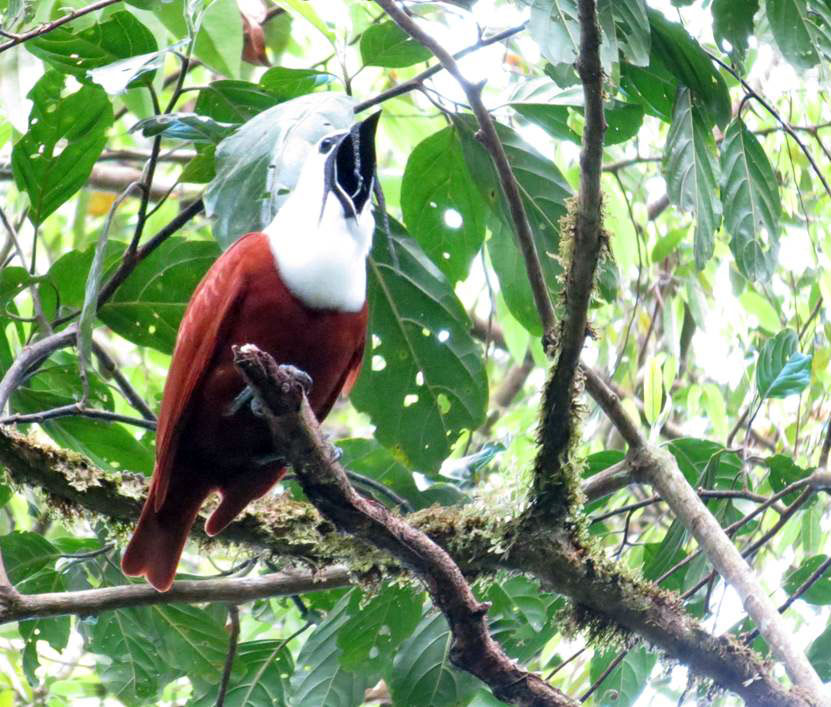
The birders wanted to see the three-wattled bell bird (Procnias tricarunalatis) which lives in this area. Walter led us to where he usually sees the bird and within moments we were encircled by their sound before one came into sight. It was a surreal moment—being surrounded by jingly, metallic sounds coming through the misty forest. These bell birds are strange looking creatures with three waddles coming from over the beak. When they call, they open their beaks so wide that it almost looks like a snake with an unhinged jaw. Its conservation status is listed as "vulnerable" mainly due to habitat loss.
While out hiking around at Las Tablas, we passed a large, metal structure near the roadway. Walter told us that a number of years ago, there was a jaguar roaming around the farm community up there—attacking the cows, goats, and dogs. The community devised a plan to trap the jaguar and transport it to an area away from where people lived. They constructed this large trap, baited it with an unlucky dog, and actually caught the jaguar!
A feeder located near the Lodge's kitchen attracts several local bird species. Many guests who arrive here jump out of their cars with binoculars already around their necks to begin bird watching the second their feet hit the farm grounds. Dejeanne, a field assistant on my crew, has taken some really nice photos of some of the birds. I will try to include a couple each week for all you bird lovers.
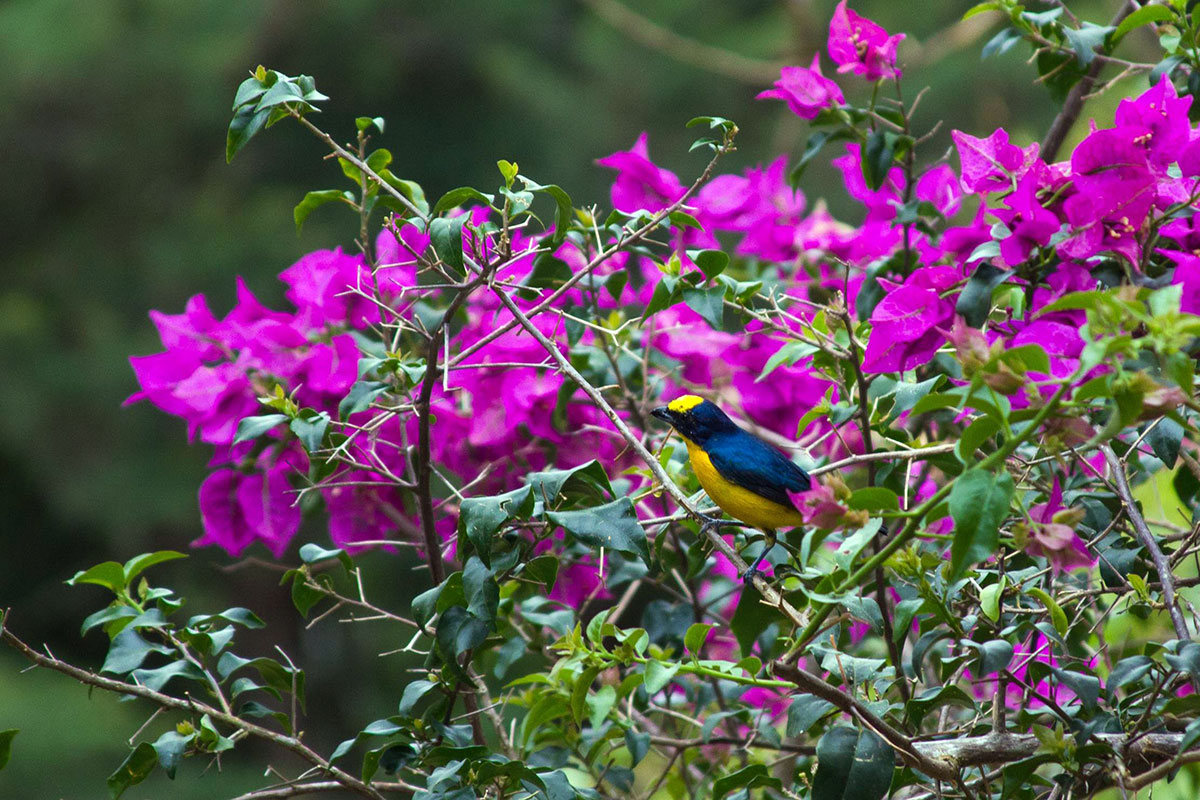
In the field this week, we have been walking through each of our 18 sites and checking on the status of the coffee flowers. There are some flower buds on the coffee plants. Some of them look like they could bloom in the next week or so. It would definitely help if we could get some rain! We are being patient and keeping busy as we wait.
I would like to introduce another of my field assistants, Julia Brokaw, who recently graduated with a degree in Natural Resources and Applied Ecology from Cornell University. She is originally from Pennsylvania and completed a project at the Las Cruzes OTS Research Station in San Vito last fall.

- What were your reasons for wanting to work on this project?
- I love studying bees and this project seemed like an incredible opportunity to research important pollinators while working closely with the farm owner. I plan to go to graduate school to study pollination ecology and this project is a great way to gain experience in the field. It is an interesting system and study set-up, not only looking at proximity to forest habitat but also comparing shade and sun grown coffee on an organic farm. I was also excited to be able to work closely with the owner, Don Roberto, to share our research findings with him and the community. He is an influential figure in coffee agriculture and management and his interest in coffee pollinator research is really exciting.
- What are your favorite parts of the research project so far?
- My favorite part of the project is watching bee visitation to the coffee flowers. In order to document how many bees are visiting flowers, we stand next to a coffee tree in full flower for fifteen minutes to watch the bees coming in to pollinate the flowers. The sweet jasmine smell of coffee flowers is wonderful and taking the time to watch bees is one of my favorite things to do. And of course, living on this farm in the beautiful tropical highlands is amazing. We are adjacent to Amistad National Park and it is incredible to see huge expanses and mountains of primary tropical forest. I also love getting to know the wonderful people here who share their knowledge of the wildlife, recipes, and the history of the area.
- And lastly, what is your favorite local food?
- My favorite local foods would have to be plantains and bananas and all the ways they cook them—fried, baked, chopped and mashed with sugar… Who knew there were so many wonderful ways to cook bananas? I also enjoy the breakfasts with "gallo pinto," a classic Costa Rican rice and beans dish. Lupé, the cook at the lodge, makes the best gallo pinto that I've had in Costa Rica!
La Roya
I don't know who said that roosters crow at dawn. This morning they started in at 4 a.m., a good hour and a half before dawn. Luckily, we are on a coffee farm and I had a nice strong cup from this year's crop that will keep me running at least until this afternoon. Don Roberto, the owner of Finca La Amistad, gave us a tour of the coffee processing plant, or "beneficio" in Spanish.
It is an intricate system of shiny machines and channels, reminiscent of Willy Wonka's Chocolate Factory. The machines weigh, peel, wash, and dry the coffee transforming the coffee berry into what is called green coffee, which is the coffee seed or coffee bean before it is roasted. The coffee plant on this farm uses principles of sustainability. They recycle the water that was used to wash the berries back through the plant to carry the coffee berries down the channels. The heat for the drying system is fueled by burning pieces of wood from dead trees on the coffee farm and coffee parchment, which is the brittle layer of skin on the outside of the coffee bean. The ashes are then mixed with compost and put back on the farm as organic fertilizer. It is a really impressive system.
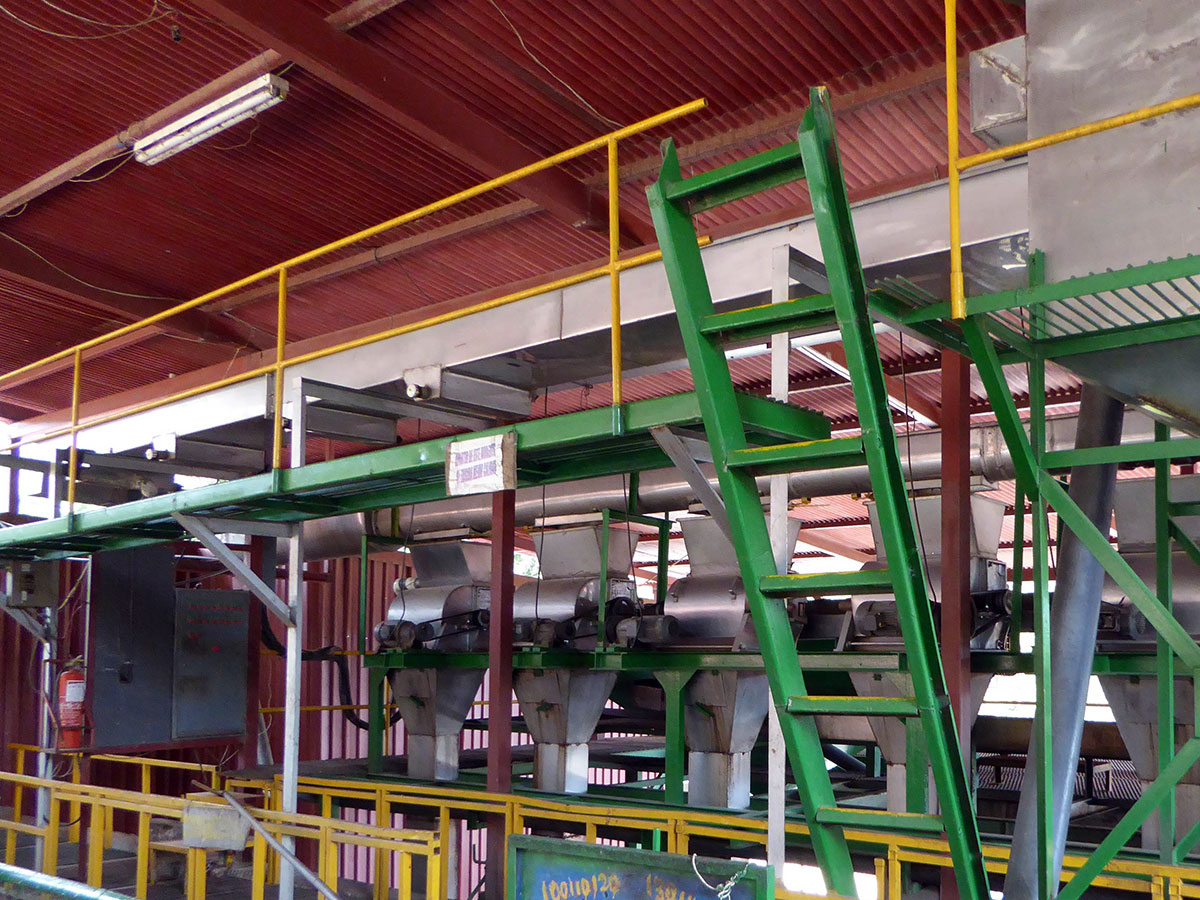
We incorporated a trip to the Las Cruzes Organization for Tropical Studies (OTS) research station in San Vito into our weekly grocery store outing. They were kind enough to let us borrow a microscope for a couple of weeks so that we can identify bees. The research station grounds and the Wilson Botanical Gardens are beautiful and worth seeing if you are in the area.
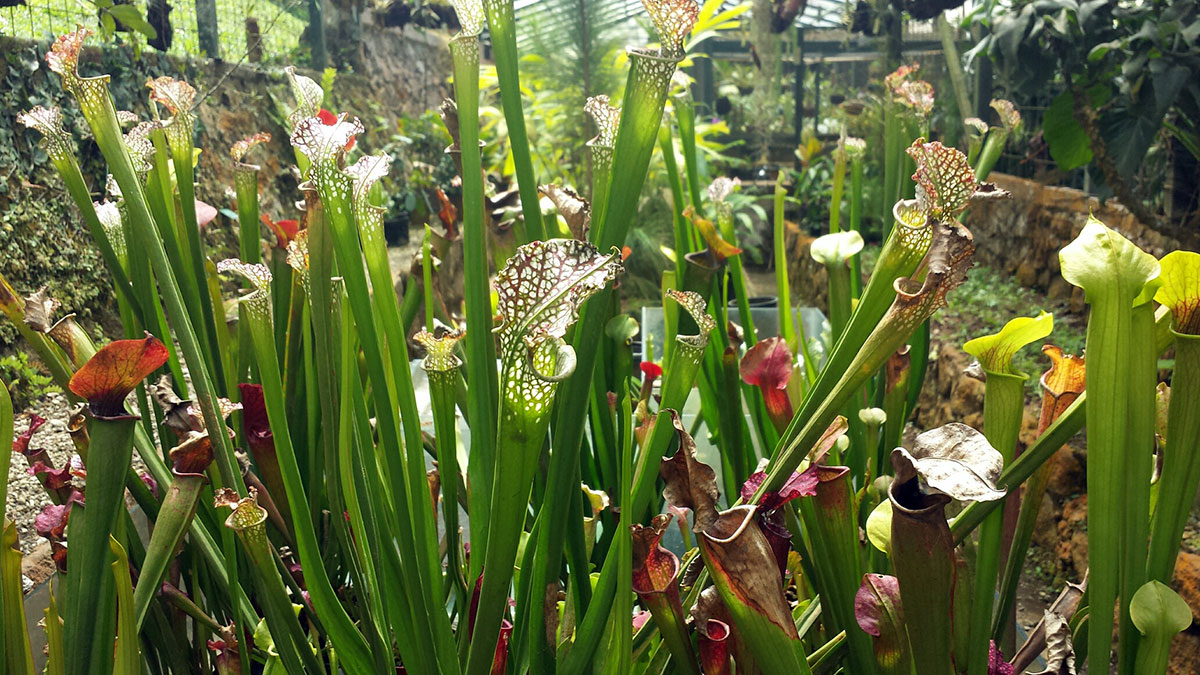
Our grocery store trips are the only time during the week that we get off of the farm property. The farm is really large though, so we aren't going stir-crazy (yet). To leave the farm we have to hike up the mile-long driveway to a bus stop on the main road. We are trying out all of the grocery stores in each of the little towns that surround the farm. Last week, we went to one in La Union that we heard was good.
We caught the bus and had to walk about 15 minutes down a dirt road to the grocery store. The bus only runs four times a day—if we don't catch the 10 a.m. back to the farm, the next one isn't until 3 p.m. We made it to the grocery store around 8:30 a.m. and the sign on the door said it didn't open until 10 a.m.…so we went back to a gas station that we had passed to see what other transportation options we had. While talking to the gas station attendant, we came to learn that the grocery store was actually in Panama, which is an hour ahead of Costa Rica. So the grocery store was opening at 9 a.m. Costa Rican time—the perfect amount of time to get our groceries for the week and catch the 10 a.m. bus back to the farm.

We are still waiting for the coffee to flower. We finally had some rain one day last week. They tell us that the coffee will flower 15 days after a good rain…so we still have a little while to wait. In the meantime, we are using this opportunity to collect data on the health of the coffee plants on the farm. La roya, or coffee leaf rust in English, is a fungus that has devastated coffee farms in Central America for the past couple of years. The USAID estimates that there has been over $1 billion dollars of damage caused by the rust since 2012. Unfortunately, La Amistad, the coffee farm where we are working, was not spared.
The farm owners have tried a number of approaches to combat the leaf rust organically. They think they have finally found a combination of methods that will work. However, the process is very labor intensive and involves spraying the plants several times a year with a mixture of 6 or 7 organic solutions and keeping the herbaceous layer of ground cover under control since they have found dormant rust spores tend to hide in the weeds. The research that I've seen on coffee leaf rust and shade is conflicting. Some research shows that if you have more shade trees within your site, the humidity within the microclimate is increased and therefore it allows the rust to thrive. But then there are other studies that say that shade trees within coffee could buffer the wind on which the rust spores are carried and therefore hinder the spread of the rust.
My field team and I are going through each of our sites to characterize the extent of the coffee leaf rust on the coffee plants. We may to help shed some light onto this question of shade and roya if we can detect any statistical differences between our shade and sun sites. I would like to introduce my field team for this project by adding a profile for each of team member at the end of the next couple of blogs. The first in line is Dejeanne Doublet. She hails from El Paso, Texas and graduated with a degree in Environmental Science a year ago from Boston University.
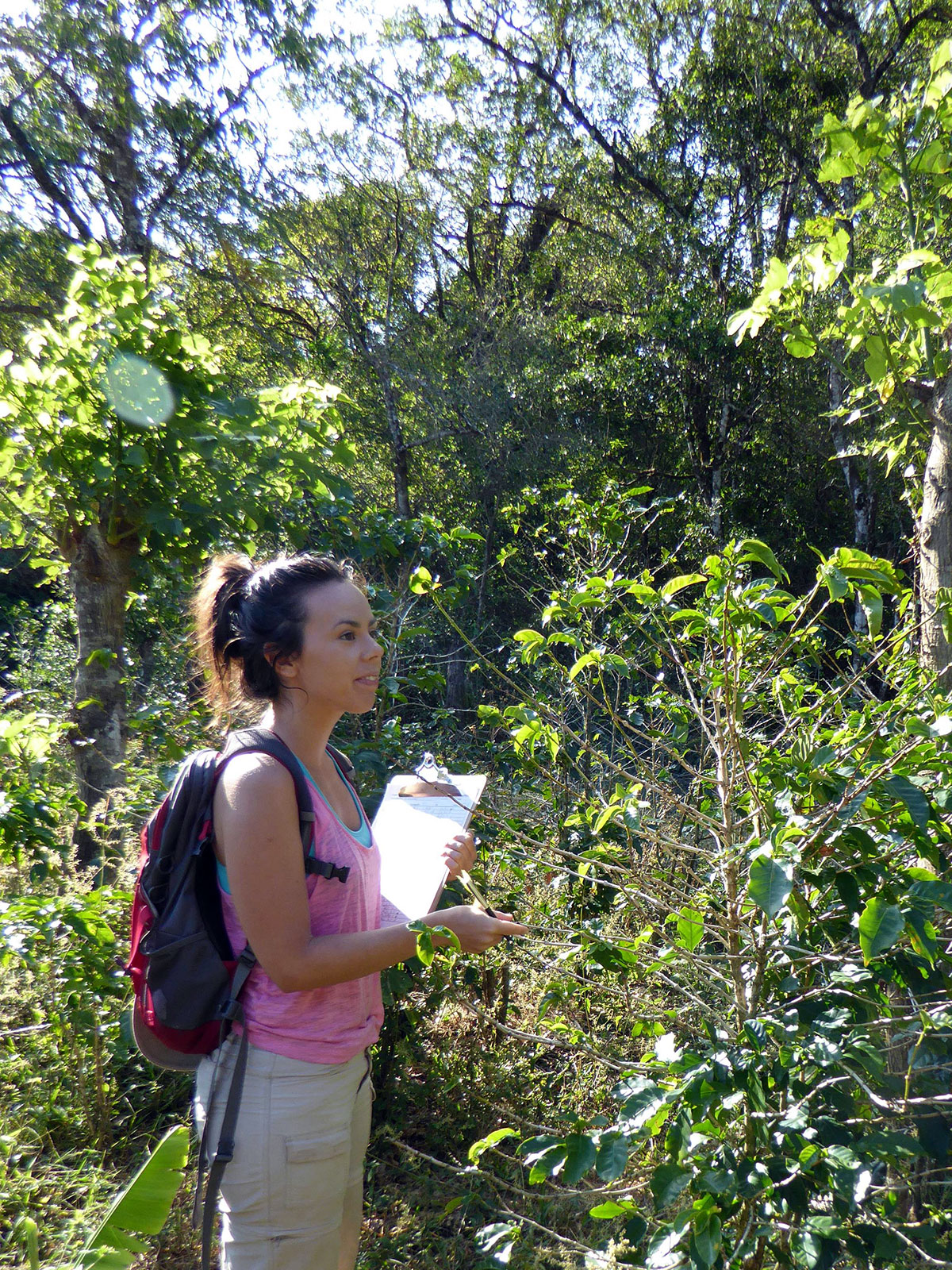
- What were your reasons for wanting to work on this project?
- I decided to come work as a field assistant for this study here in Costa Rica for a couple reasons. Firstly, I love the challenges and constant problem solving that comes with conducting ecological field research—you're always on your toes and revising your plans. I'm especially interested in research that can have a real-world impact, which is exactly what pollination and coffee research provides. Costa Rica, with a high level of biodiversity and large areas of agricultural land, is an especially interesting place to conduct this kind of research. Of course, I also enjoy the adventure of traveling to a new country.
- What are your favorite parts of the research project so far?
- My favorite part of this experience has been being able to not only work but also live on a coffee farm. We've been welcomed into the farm by the owner and the workers here and have been able to get a sense of the day-to-day life here (aka the pura vida) which incorporates a lot of hard work but also a strong value on community and family.
- And lastly, what is your favorite local food? (I had to limit them to three because when I asked the question, they all started rattling off like 20 different foods).
- Where to begin?! Costa Rican food is just the right amount of spicy and the right amount of hot (according to Costa Ricans, these are two very different things.) My favorite dish is the typical meal of white rice and black beans with seasoned fish and a side of the oh-so-amazing platanos maduros (fried plantains), which are simply ripe plantains fried in oil. I also love a fruit called granadilla that you crack open to find small seeds held together by a gooey gel that you slurp up. Yum!
Site Set-up
We are at the end of our third week here on the coffee farm and have spent the last seven days familiarizing ourselves with the vegetation and location of each research site. Vegetation analysis is tedious work requiring meticulous focus on each of the measurements taken, but it is important. We assess the tree species, tree height, density of coffee plants, amount of shade cover, ground cover, basal area, coffee plant height…I'm worn out just writing about it! We take all of these measurements to characterize the habitat in order to quantify what we are seeing on the ground. This way we can compare the vegetation across sites on this farm and also with other coffee farms.

I want each of my field assistants to come away from this research feeling comfortable leading a project on their own. We talk through how to analyze situations and make decisions while remaining flexible, because nothing in the field ever goes as planned. Adjustments always have to be made especially when you are working on an operating coffee farm, where, in addition to my team conducting research, a crew of coffee farmers are actively working.
There are about 120 employees working on this farm picking coffee, pruning the shade trees, pruning the coffee plants, and clearing brush. We spent a lot of time selecting and setting up the 18 sites where we will do the pollination work. We have 9 sites where coffee is grown under shade cover and 9 sites with sparse vegetation/no shade. In both of these categories, we have sites that are right along the forest edge, then 50 meters, and 150 meters from the nearest forest edge. Finca La Amistad is surrounded by forest on 3 sides, so locating allof the sites took a lot of maneuvering and strategizing.
We would lay out one site that was supposed to be at the 150 meter distance class only to find that it was only 40 meter from the other side of the forest, and had to be relocated. The site set-up is not hard, it just takes planning and patience. The first day after we set up the sites, we went back to the sites to start the vegetation analysis and couldn't find our flagging that we marked for the first site. The coffee farm crew had come through and pruned all of the coffee, accidently lopping off the branches where our site flags were tied. (Of course, we also have the sites marked in the GPS—but GPS points can have about ± 5-10 meter accuracy. This might seem like a small amount in the grand scheme of things—but in a coffee farm when you are surrounded by coffee plants that all look the same, that small distance matters.)
We hadn't done any vegetation analysis yet for the site, so we just remarked it and moved onto the next site. Then we arrived at the next site, same thing—pruned coffee, no flagging. We remarked and moved on to the third site on the list, and again found pruned coffee, no flagging. Finally, at the fourth site we visited that day, we found our markings intact. Every day since, our site markings have been there. We decided to tie our flagging to a tree trunk instead of the coffee plants if there is a shade tree nearby.

I have already noticed a lot of differences between pollination work and the mammal research, which I previously conducted, in the field. For one, bees are lazy little buggers. Once the coffee flowers, we don't start the bee visitation counts until 8 a.m. because the bees need time to warm up in the morning. With mammal studies, we have to be at the site by 7 a.m. at the latest to open the traps and release the animals. Then birds—well, they are up before the crack of dawn.
I have also noticed that pollination work is very clean, especially in comparison to small mammal work. With bees, you don't have to use hand sanitizer between the sites or even before you eat lunch in the field because you haven't handled mice or dirty traps. I always have a rule that field clipboards cannot be put on the kitchen table since we use the back of them as a flat surface to measure the length of the mouse body in the field, which is not so sanitary on the table, but the kitchen table is fair game for field clipboards in pollination studies!
Also, eating peanut butter and jelly sandwiches for lunch in the field is much more appetizing with pollination studies. The sandwiches' resemblance to the peanut butter mixture we used as bait in mammal traps was a bit too close for comfort! Lastly, there is a lot less equipment involved, about 100 pounds less judging from the luggage scale at the airport since we don't have heavy metal traps in our backpacks to set up the sites. I must say though, I do miss those little furry guys. We have set up some camera traps in the forest behind the coffee, just to see if we can get some images of animals that could be living in the forest. Stay tuned for those results…
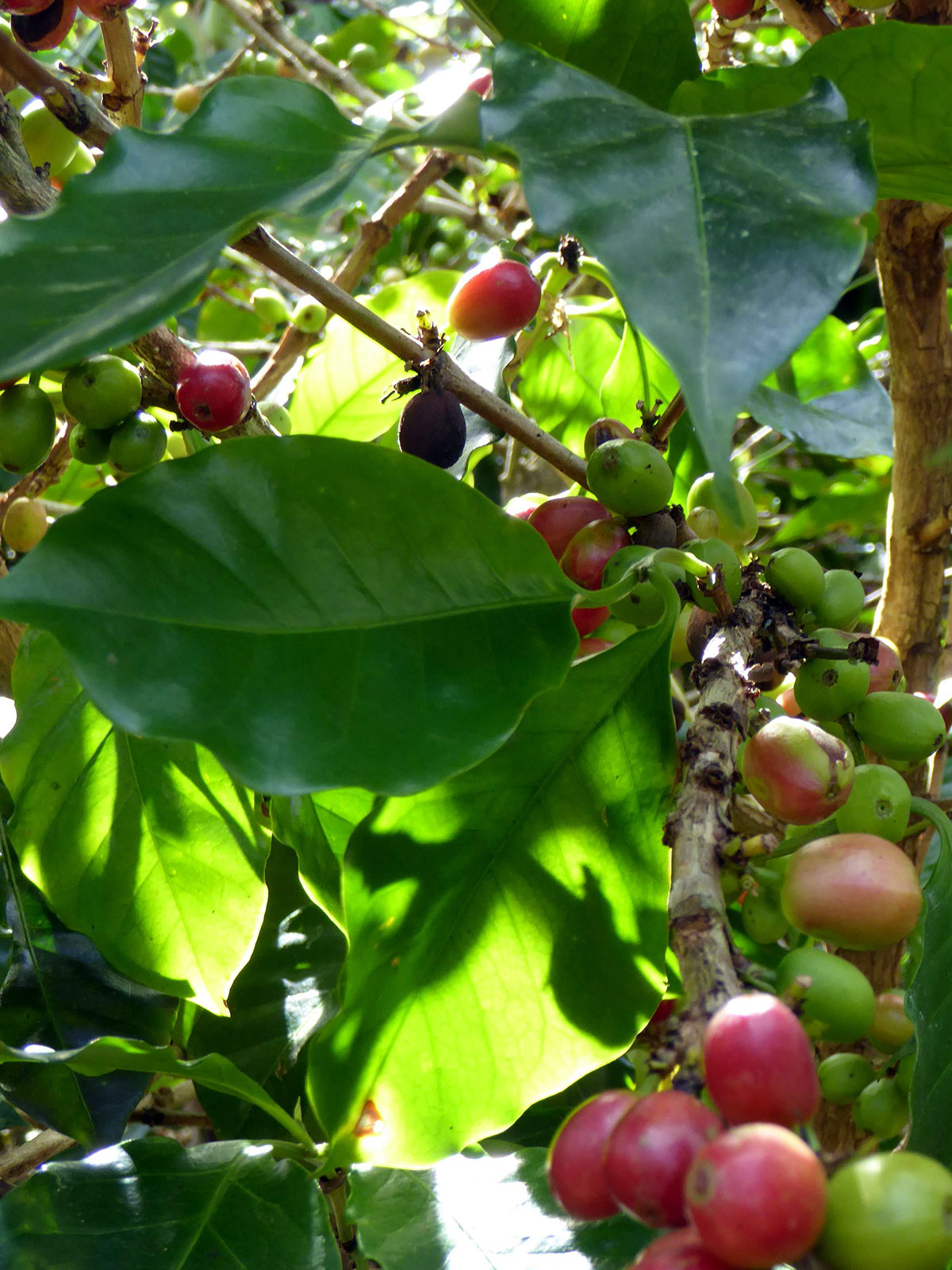
So this coming week, we wait for the coffee to flower. There are some buds on the plants and some coffee flowers starting to peak their heads out. I think we will have at least another week or so before they are in full bloom. In the meantime, we will hike to each of our sites to check on the status of the flowers (and our flagging), practice taking the visitation data and bee netting, check the camera traps, and hope for the rain that is needed for the coffee bloom.
Organic Coffee
Our first week on the farm has been great. We are starting to find our way around, although we did get lost a couple of times…
This coffee farm, Finca La Amistad, has been owned and managed by the same family for over three generations. For the past 35 to 40 years, it has been organic. When I asked the owner, Don Roberto, what made him decide to become organic he told me that about 40 years ago, there was an insect that was plaguing the coffee farms throughout the area.
Most farmers started spraying very toxic chemicals to combat this pest here in southern Costa Rica and in Panama. The spray killed everything in sight -all the insects, bugs, birds. Don Roberto thought that was the wrong way to go.
He enjoys watching the wildlife on his farm and didn't think killing everything was the right decision. It was about this time that he met an organic vegetable farmer from Georgia through a friend. They started talking and the farmer invited him to see the vegetable farm.
Once Don Roberto saw the vegetable farm and how it was managed, he knew wanted to do that with his coffee. His farm became one of the first certified organic coffee farms in Central America.
At that time, they did not have certifying agencies here in Costa Rica, so a certifying agency in Florida came down to certify his farm. Through conversations with him, it is apparent that organic coffee farming is not easy. Combating diseases and insects without inorganic pesticides takes a lot of time, effort, and manpower. There is a lot of trial and error involved to figure out which methods or combination of methods work best.
One thing that I've heard about organic farming is that the coffee yield decreases for the first several years. The coffee plants have to adapt to this new management system and can become plagued by diseases and insects that were formally kept at bay by agrochemicals. I asked Don Roberto when his coffee yield came back up to what it was before he was organic, he said it took many years, some parts of the farm just came back to the same yields a couple of years ago.
With all that work and sacrifice in yields, there are payoffs. The farm employs dozens of families, there are a ton of birds and other wildlife nearby, and the coffee is delicious!

This past Sunday, my field assistants and I were invited to help Don Roberto and his family pass out book bags and school supplies to the children of the people that work on the farm. The school year in Costa Rica starts in February, so the school kids are just coming off of their summer break. About 50 kids were here for the ice cream and cake party, ranging from about 5 years old to seniors in high school.
Don Roberto and his family throw this school year kickoff party every year. He wants the kids to have everything they need to excel at school and keep with their studies. I'm glad that we could be here for the party! It was fun.
My field assistants this year all come from US, which I think is a first for my field teams. They all just graduated in May (I am the old lady of the crew) Kristian graduated from UVM where he worked on a couple of different pollination studies. Julia graduated from Cornell and was just in this area a couple of months ago doing some work on pollination and orchids. Dejeanne graduated from Boston University and recently completed an internship at Smithsonian Environmental Research Center.

We are all living in a cabin on the coffee farm. We have 3 bedrooms and bathroom (with hot water for the shower)! It is actually kind of chilly here in the mountains at night. It can dip into the 60's, which I know is nothing for all of you in the dead of winter in the States right now.
There has also been a drought here for the past several months making everything dry and dusty. It has starting to rain here a little bit, but before this week, it had not rained since Novembe, which is rare for this area. The coffee needs a couple of good rains before it will flower, so this year the coffee will flower a little later than usual on the farm. I am personally ok with the coffee flowering a little late.
It will give my field team and I extra time to set up all the sites, learn how to get to each of them, and get some vegetation analysis in before the coffee flowers. Once it flowers, we will have three days to collect all of pollination data before the flowers wilt and fall to the ground. We have planned a couple of dress rehearsals before show time, not to worry.
Pollination Study
I will be living on a coffee farm in southern Costa Rica for the next two months to do research on pollinators. There is a variety of management systems on coffee farms—from farms where coffee is grown in the understory of forests with tons of trees (shade) to farms that are a monoculture of coffee plants with no other trees in sight (aka sun coffee). There has been a lot of research that shows that the coffee farms that mimic native forests provide resources and habitat for wildlife. My own research with mammal communities echoes these findings as I have consistently found high mammal diversity within coffee farms that have more shade trees planted in and around the coffee farm.
This field season, I am switching it up a bit. Instead of mammals, my field crew and I are looking at pollinators in coffee farms. Does the way that the shade trees are managed also influence the diversity of pollinators? I've been interested in studying ecosystem services within coffee farms for a while. Ecosystem services are natural environmental processes from which we, as humans, benefit—things such as food sources, pollination, and water clarification. Most of the time these services are taken for granted and we don't realize how important they are until something starts to go awry.
Arabica coffee (the predominant coffee species in Central America) is self-pollinating. That means that it does not actually need bees for pollination—however, studies have shown that additional pollination by bees can increase the coffee yield by 30-50%! So it would be in the farmers' best interest to manage the farm in a way that would provide good habitat for bees.

The start of a new field season is always a bit bumpy. You worry about getting all of your equipment together and making sure you have everything you will need—especially when you are working in isolated areas that do not really have regular mail service or FedEx. You then have to figure out how to get all of the equipment and supplies packed and hope that you are strong enough to carry it all! Then, of course, you have to make it to your field site…
This year, there was snow on the ground when I flew out of Washington, DC, causing my flight to be delayed, which meant that I had to run to my connecting my flight. I just barely made the next flight, but my luggage did not. Then the rental car broke down as Bob Rice, my advisor at the Migratory Bird Center, and I were driving from the airport in San Jose, Costa Rica to the site near San Vito. We made it about 3 hours into our 6 hour trip. So yeah, the new field season started off a little rough—but we made it the farm safe and sound and eventually, my luggage did too.

The coffee farm where we are working is absolutely beautiful. It is a large, certified organic coffee farm adjacent to the La Amistad International Park that separates Costa Rica from Panama. It is the perfect place to investigate not only the different management systems within coffee, but also the influence that close proximity to forest has on the pollinators. We will set up our study sites to try to understand both of these aspects. First though we have to find our way around this 300 hectare (roughly 740 acres) coffee farm…we have a couple of maps, a compass, and a GPS unit…how hard could it be?
